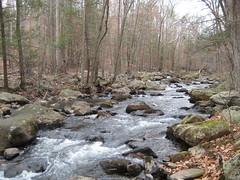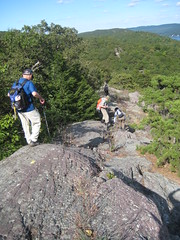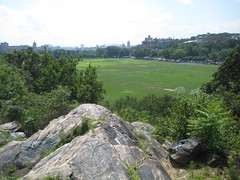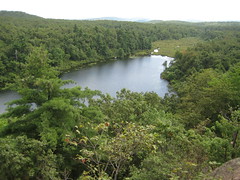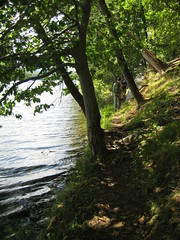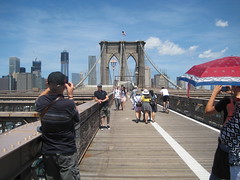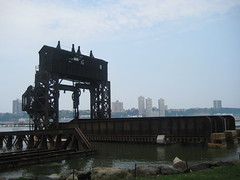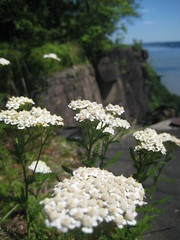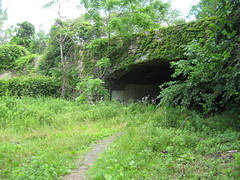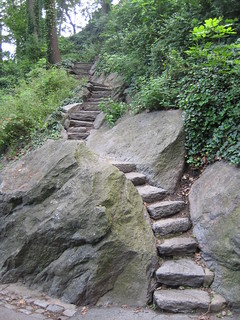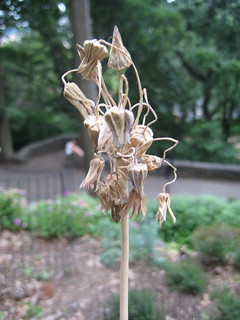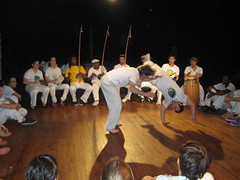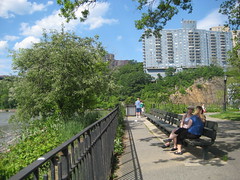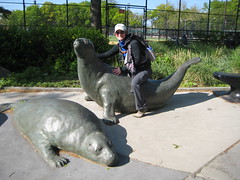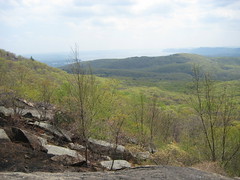- In addition to including students from lower-class backgrounds who are aiming at upward mobility, the New Outsiders also include middle- and middle-upper-class students concerned about downward mobility
- A tight job market that increasingly requires graduate degrees, although law school is looking less desirable as "firms are saturated" (p. 286)
- Grade inflation, grade-grubbing, and cheating
- Participation in extracurriculars, including Greek life, because it looks good on the resume
- High levels of student anxiety, coupled with "partying" that seems more like the pursuit of fun than actual fun
- "Today's New Outsiders seem content to remain emotionally and economically dependent on their parents" (p. 271)
Tuesday, December 18, 2012
Campus Life
I recently finished Helen Horowitz's Campus Life, a history of the campus life of the American undergraduate. The book was published in 1987, so as another scholar mentioned via Facebook, it's not exactly up-to-date. Certainly, there have been changes in college life in the interim 25 years: Residence hall life is considerably plusher, the internet has changed life on and off campus, and the preppy look she describes as ascendant in 1983 has contracted to its New England roots. But what struck me forcefully is how little the underlying college culture has changed.
Horowitz breaks students into three categories: Joe Colleges, who tend to come from the upper strata, in college to have a pleasant social experience, and are big joiners; the outsiders, who either can't afford, are refused, or don't wish to "join" and instead focus on their schoolwork; and the rebels, either political or artistic, who had their moments of glory in the 1930s and 1960s. At the end of the book she describes the New Outsiders, ascendant in the 1980s, who are focused on their grades, albeit for vocational reasons rather than as mere signifiers of learning. To the extent that some of them are joiners, it's because the activity will help them get ahead.
Sound familiar? Here's more:
Sunday, December 16, 2012
Mount Beacon night circular hike
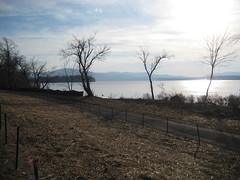 Yesterday I did a nice hike with the Ramblers along the eastern portion of the Hudson. As you probably already know, I am a huge fan of the Hudson, and the hike was much more scenically interesting than Harriman State Park. We started by taking the Metro North train to Beacon and following a greenway along the water. We walked along abandoned train tracks, following Fishkill Creek.
Yesterday I did a nice hike with the Ramblers along the eastern portion of the Hudson. As you probably already know, I am a huge fan of the Hudson, and the hike was much more scenically interesting than Harriman State Park. We started by taking the Metro North train to Beacon and following a greenway along the water. We walked along abandoned train tracks, following Fishkill Creek.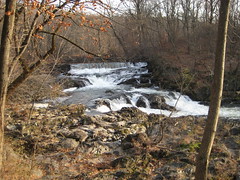 These falls are part of an old dam complex, the ruins of which we walked over. A dead giveaway is the unnatural evenness of the falls. The hike along the river thus far has been nearly flat, and it will stay that way a little longer as we head through the town of Beacon. But then you see Mount Beacon ahead of you.
These falls are part of an old dam complex, the ruins of which we walked over. A dead giveaway is the unnatural evenness of the falls. The hike along the river thus far has been nearly flat, and it will stay that way a little longer as we head through the town of Beacon. But then you see Mount Beacon ahead of you.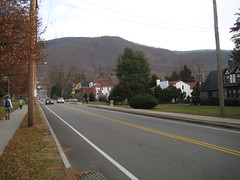 That clear line up the mountain is what used to be an incline railway. There was a casino at the top, as well as summer homes. The trail mostly follows that line, which means it is a little steep. Most of the 1500 feet of elevation gain on the hike was all right here in one shot.
That clear line up the mountain is what used to be an incline railway. There was a casino at the top, as well as summer homes. The trail mostly follows that line, which means it is a little steep. Most of the 1500 feet of elevation gain on the hike was all right here in one shot.  The ruins of the gearhouse for the funicular are at the top, along with spectacular views of Beacon and the Hudson River. At this point it was getting dark, not to mention chilly. We had elected to do this as a night hike, meaning that now the sun was setting. The trail we descended by was much gentler than our uphill route (excluding a slight off-trail diversion) and mostly followed an old road.
The ruins of the gearhouse for the funicular are at the top, along with spectacular views of Beacon and the Hudson River. At this point it was getting dark, not to mention chilly. We had elected to do this as a night hike, meaning that now the sun was setting. The trail we descended by was much gentler than our uphill route (excluding a slight off-trail diversion) and mostly followed an old road.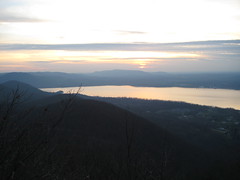 We descended to the town of Beacon and did a short tour of some of the better Christmas lights before catching the train back to Manhattan. All told, we hiked 10.3 miles.
We descended to the town of Beacon and did a short tour of some of the better Christmas lights before catching the train back to Manhattan. All told, we hiked 10.3 miles. Tuesday, December 11, 2012
The Nutcracker
As I child, I read A Very Young Dancer many times. The book was part of a series by photographer Jill Krementz. Each one followed a ten-year-old girl* who was outstanding in something like dance, gymnastics, horseback riding, etc. The star of A Very Young Dancer was a ballet student here in New York, and she played the part of Marie in the New York City Ballet's Nutcracker.
I've seen The Nutcracker performed several times, but never with Balanchine's choreography, and, of course, never in New York - until tonight.
What fascinated me was how little the production has changed during my lifetime - the book is as old as I am. Of course, the costumes aren't the same ones worn all those years ago, but many of them still look very much the same, and the sets are nearly identical. As far as I can tell, the hallway is precisely the same, down to the reflection in the mirrors. Perhaps it is still the same set. The continuity is eerily exaggerated by the fact that boys haircuts have come around full circle to what was being worn in the mid-1970s.
It was a very deja vu experience. A good show, of course, but knowing it doesn't get updated means I won't be in a hurry to see it again.
*A Very Young Circus Flyer followed a boy.
I've seen The Nutcracker performed several times, but never with Balanchine's choreography, and, of course, never in New York - until tonight.
What fascinated me was how little the production has changed during my lifetime - the book is as old as I am. Of course, the costumes aren't the same ones worn all those years ago, but many of them still look very much the same, and the sets are nearly identical. As far as I can tell, the hallway is precisely the same, down to the reflection in the mirrors. Perhaps it is still the same set. The continuity is eerily exaggerated by the fact that boys haircuts have come around full circle to what was being worn in the mid-1970s.
It was a very deja vu experience. A good show, of course, but knowing it doesn't get updated means I won't be in a hurry to see it again.
*A Very Young Circus Flyer followed a boy.
Monday, December 10, 2012
Injury update
I haven't been making it to many classes and am trying to practice at home. So I do my PT exercises, some stretches - both related, like supine twists, and unrelated, like hamstring stretches, because I always have tight hammies - and simple moves such as four of the five basic kicks.* (Martelo de solo puts too much body weight on a straight arm.) I've been focusing on armada, because Mestre has broadly hinted that would be a good idea, but I also added meia lua de compasso back in. It turns out that if I do it with perfect form, it doesn't hurt. What that means is I suck it up and do it with perfect form.
Which reminds me of this.
*In Quintal, these are considered to be meia lua de frente, queixada, armada, meia lua de compasso, and martelo de solo. In Angola Palmares, the list I was taught omitted martelo de solo but added bensao and martelo. In case you care.
Which reminds me of this.
*In Quintal, these are considered to be meia lua de frente, queixada, armada, meia lua de compasso, and martelo de solo. In Angola Palmares, the list I was taught omitted martelo de solo but added bensao and martelo. In case you care.
Thursday, December 6, 2012
Injured!
My left arm had been hurting ever since my flu shot, but it got particularly painful after one acrobatic capoeira class. As a side effect, the muscles all around my shoulder blade seized up in a death grip. I finally gave in and went to the doctor, who sent me off to physical therapy.
It turns out I suffer from a weak serratus muscle (the muscle that stabilizes the shoulder blade) and a small impingement in the rotator cuff. So the therapist has me on home exercises as well as in-office visits. She also has me off of any exercise that puts my weight in my hands, or that hurts.
This means no yoga class (there are plenty of moves I can do at home, but a class will have too many poses that rest on the arms) and highly modified capoeira classes. No cartwheels, no kicks or escapes that put my weight on my arms. I do cheat a little occasionally and put my weight on my good arm, though. This means I have to stick to the easier classes, as the more advanced classes get into too many sequences that use the arms or outright acrobatics.
I hate hate hate being injured and not being able to do things, especially when they are things my body is capable of, and even more when they don't hurt, such as queda de rins - I don't have pain on bent arms. I feel like, by the time I recover, I will have lost so much strength. If I weren't in the thick of final exams, there would be lots of hiking to at least get out my energy.
I'm not a fool. I try to be a good patient, because I don't want to get hurt worse. And I'm relearning how to use my shoulder blades (who knew you could use them wrong?)
Maybe at least I can improve my armada during this period?
It turns out I suffer from a weak serratus muscle (the muscle that stabilizes the shoulder blade) and a small impingement in the rotator cuff. So the therapist has me on home exercises as well as in-office visits. She also has me off of any exercise that puts my weight in my hands, or that hurts.
This means no yoga class (there are plenty of moves I can do at home, but a class will have too many poses that rest on the arms) and highly modified capoeira classes. No cartwheels, no kicks or escapes that put my weight on my arms. I do cheat a little occasionally and put my weight on my good arm, though. This means I have to stick to the easier classes, as the more advanced classes get into too many sequences that use the arms or outright acrobatics.
I hate hate hate being injured and not being able to do things, especially when they are things my body is capable of, and even more when they don't hurt, such as queda de rins - I don't have pain on bent arms. I feel like, by the time I recover, I will have lost so much strength. If I weren't in the thick of final exams, there would be lots of hiking to at least get out my energy.
I'm not a fool. I try to be a good patient, because I don't want to get hurt worse. And I'm relearning how to use my shoulder blades (who knew you could use them wrong?)
Maybe at least I can improve my armada during this period?
Thursday, November 29, 2012
Harriman hike
This past Sunday I did a 10.6-mile hike with the NY Ramblers in Harriman Park. The weather was perfect - cold but not windy or rainy.
Thursday, November 22, 2012
ASHE 2012
I spent last week in Las Vegas at the Association for the Study of Higher Education conference. Vegas was a much more exciting venue than we usually have, so I imagine that next year in St. Louis we'll be looking around woefully, asking, "Where is my giant bathtub?" Yes, my room at The Cosmopolitan was actually larger than my apartment in Manhattan. And the weather was perfectly delightful, unlike Vegas in the summer.
The conference itself was also excellent. I only presented a roundtable, so low stakes there, but I went to a few interesting presentations, a couple of meetings, and some receptions. As always, one of the best parts of the conference was catching up with scholars and friends I see once or maybe twice a year.
The conference itself was also excellent. I only presented a roundtable, so low stakes there, but I went to a few interesting presentations, a couple of meetings, and some receptions. As always, one of the best parts of the conference was catching up with scholars and friends I see once or maybe twice a year.
Monday, November 12, 2012
More and faster
A staple of the movie news is "star beefs up workouts for movie role." In this story, for example, one actor worked out eight hours a day for ten weeks. The "easiest" part of those eight hours was two hours of choreography.
I have no idea how people do things like that. Not that working eight hours a day is impossible; it's just … going from working out an hour or two a day to eight? I mean, I know movie stars stay in shape as part of their job, but I assume they don't spend their whole day doing it.
Whenever I ramp up my workouts, my body feels it and takes a while to adjust. (Like, you know, 99% of people.) When I started capoeira, for example, I blogged about how I went to yoga and was unable to do a single chaturanga. When I joined Quintal, I started going to three classes a week. Previously, I had been doing two, and while the new classes were shorter, they were much more intense. I remember drinking what felt like gallons of water in my first few classes. A couple of months ago, I switched to an unlimited plan, and now I go to five-six classes a week. My body is still adjusting.
Friday night I went to our roda, although I didn't play much at all. I told Tarugo that I might come to his Saturday class, although it would depend how physical my volunteer morning at Van Cortlandt was. Turned out it wasn't very, so I went to his class, but as I told him, "I'm tired and sore and probably shouldn't be here." Luckily, we spent the class working our backs and arms, and it was my legs that were already shot. Sunday, I found I couldn't do side plank on the left in yoga. (Monday is my rest day … thank goodness.)
I know one struggle for me is getting enough protein, and maybe that makes a difference in recovery time, but really, I don't think what I am experiencing is that different from most people. (Perhaps, like a movie star, I should have a personal chef.) But I have this impatience - I want to get better faster! and my body is putting the reality check on it. If worked out eight hours a day, I'd get stronger at first - then I'd get injured. No thanks!
Yet, progress happens. I remember the first time I was able to get from a wide-legged forward fold to tripod headstand in yoga. It happened a few months before leaving Nashville, so let's say almost two years ago. I was super-excited. Just yesterday I realized I was able to control my descent enough to set my feet down silently when coming back out. It's not the dramatic part of the move, but it's just as important, and it means I have a kind of core control I didn't have before. That control has been coming along slowly and incrementally, but that moment of breakthrough is always something.
I have no idea how people do things like that. Not that working eight hours a day is impossible; it's just … going from working out an hour or two a day to eight? I mean, I know movie stars stay in shape as part of their job, but I assume they don't spend their whole day doing it.
Whenever I ramp up my workouts, my body feels it and takes a while to adjust. (Like, you know, 99% of people.) When I started capoeira, for example, I blogged about how I went to yoga and was unable to do a single chaturanga. When I joined Quintal, I started going to three classes a week. Previously, I had been doing two, and while the new classes were shorter, they were much more intense. I remember drinking what felt like gallons of water in my first few classes. A couple of months ago, I switched to an unlimited plan, and now I go to five-six classes a week. My body is still adjusting.
Friday night I went to our roda, although I didn't play much at all. I told Tarugo that I might come to his Saturday class, although it would depend how physical my volunteer morning at Van Cortlandt was. Turned out it wasn't very, so I went to his class, but as I told him, "I'm tired and sore and probably shouldn't be here." Luckily, we spent the class working our backs and arms, and it was my legs that were already shot. Sunday, I found I couldn't do side plank on the left in yoga. (Monday is my rest day … thank goodness.)
I know one struggle for me is getting enough protein, and maybe that makes a difference in recovery time, but really, I don't think what I am experiencing is that different from most people. (Perhaps, like a movie star, I should have a personal chef.) But I have this impatience - I want to get better faster! and my body is putting the reality check on it. If worked out eight hours a day, I'd get stronger at first - then I'd get injured. No thanks!
Yet, progress happens. I remember the first time I was able to get from a wide-legged forward fold to tripod headstand in yoga. It happened a few months before leaving Nashville, so let's say almost two years ago. I was super-excited. Just yesterday I realized I was able to control my descent enough to set my feet down silently when coming back out. It's not the dramatic part of the move, but it's just as important, and it means I have a kind of core control I didn't have before. That control has been coming along slowly and incrementally, but that moment of breakthrough is always something.
Sunday, November 11, 2012
Yoga studio: Laughing Lotus
Laughing Lotus is a studio I'd been meaning to try for a while, so I finally bought a three-class pass. That means that my comments below are based on a very small subset of classes, and I can't comment on most of the teachers. However, I am sure I will be back.
First off: It's a very owner-driven studio. They actually have two studios, the other being in San Francisco, and both of the owners still teach and are very visible.* The studio reflects their style. I know at least one yogi that would hate it, as it's definitely an American take on things. If you like a meditative, traditional, music-free class, this definitely isn't the studio you are looking for.
The space itself looks as if it was decorated by the love child of Betsey Johnson and Ganesh. (It advertises that it has the world's only glitter bar.) While your taste may vary, from a practical perspective the space works well for yoga - hardwood floors, lots of light.
One of the classes I went to was fine, but nothing worth writing home about. The other two were taught by Dana Flynn, one of the owners. She has the kind of oversized personality that makes most of the people she meets want to sleep with her, be her, or follow her around Phish-style. Both classes were her Sunday Revival/Gospel Flow.
Despite the name, there isn't much gospel music; it's upbeat pop, mostly. (Think "Walk This Way" and "Dance Hall Days.") The class is a nonstop flow until the very end, and the focus is very definitely on moving rather than alignment. I don't know if this is true of all of Laughing Lotus's classes. If it is, I wouldn't want it to be my sole studio. But the class is what it aims to be: uplifting. I wouldn't be entirely shocked if someone started speaking in tongues in the middle of class one day.
The class is billed as a level 2 (of 3), and it includes quite a few optional arm balances, but most of the poses are less notable for their innate difficulty than for being strung together into fast-moving sequences.
If you like to use the words "yoga" and "party" in the same sentence, you'd probably enjoy Laughing Lotus.
*I'm working on a theory of yoga studios that divides them into owner-driven, guru-driven, and investor-driven.
First off: It's a very owner-driven studio. They actually have two studios, the other being in San Francisco, and both of the owners still teach and are very visible.* The studio reflects their style. I know at least one yogi that would hate it, as it's definitely an American take on things. If you like a meditative, traditional, music-free class, this definitely isn't the studio you are looking for.
The space itself looks as if it was decorated by the love child of Betsey Johnson and Ganesh. (It advertises that it has the world's only glitter bar.) While your taste may vary, from a practical perspective the space works well for yoga - hardwood floors, lots of light.
One of the classes I went to was fine, but nothing worth writing home about. The other two were taught by Dana Flynn, one of the owners. She has the kind of oversized personality that makes most of the people she meets want to sleep with her, be her, or follow her around Phish-style. Both classes were her Sunday Revival/Gospel Flow.
Despite the name, there isn't much gospel music; it's upbeat pop, mostly. (Think "Walk This Way" and "Dance Hall Days.") The class is a nonstop flow until the very end, and the focus is very definitely on moving rather than alignment. I don't know if this is true of all of Laughing Lotus's classes. If it is, I wouldn't want it to be my sole studio. But the class is what it aims to be: uplifting. I wouldn't be entirely shocked if someone started speaking in tongues in the middle of class one day.
The class is billed as a level 2 (of 3), and it includes quite a few optional arm balances, but most of the poses are less notable for their innate difficulty than for being strung together into fast-moving sequences.
If you like to use the words "yoga" and "party" in the same sentence, you'd probably enjoy Laughing Lotus.
*I'm working on a theory of yoga studios that divides them into owner-driven, guru-driven, and investor-driven.
Tuesday, October 30, 2012
Sandy came to town
Sandy swept through New York last night, and let me tell you, I was very lucky to be where I was. The Upper West Side got off very lightly; I haven't lost power, and I haven't seen any major damage in my my immediate neighborhood. As you already know, much of the city and nearby areas were not so lucky and have sustained major damage.
The sign down in the photo was unusual enough that I wasn't the only one photographing it. The fact that a down sign was a big deal - as opposed to flood waters, floating cars, or fire damage - tells you a lot about how fortunate we were.
In Riverside Park, many small branches and a few trees were down, but frankly fewer than after Irene. I tried to go down to the Hudson River Greenway, but the police were blocking off the entrance to the Cherry Walk. That didn't make much sense to me, since the park itself was much more dangerous with weakened, falling branches, but I'm not one to vault over a police vehicle without a much better reason than curiosity. (I saw a few cyclists, making me think another access point was available.)
The roads and river were mostly quiet, although helicopters were constant overhead. One boat floated out in the Hudson alone and unattended and, seemingly, undamaged.
The sign down in the photo was unusual enough that I wasn't the only one photographing it. The fact that a down sign was a big deal - as opposed to flood waters, floating cars, or fire damage - tells you a lot about how fortunate we were.
In Riverside Park, many small branches and a few trees were down, but frankly fewer than after Irene. I tried to go down to the Hudson River Greenway, but the police were blocking off the entrance to the Cherry Walk. That didn't make much sense to me, since the park itself was much more dangerous with weakened, falling branches, but I'm not one to vault over a police vehicle without a much better reason than curiosity. (I saw a few cyclists, making me think another access point was available.)
The roads and river were mostly quiet, although helicopters were constant overhead. One boat floated out in the Hudson alone and unattended and, seemingly, undamaged.
Thursday, October 18, 2012
Class divisions
I had a very brief conversation with a non-academic friend the other day about the difference in job responsibilities between adjuncts and full-timers (be they tenure-track or lecturers), when he expressed surprise I wasn't paid extra for student advising. Adjuncts are paid strictly by the course and are not expected to do work beyond that. (This is only mostly true: At my institution, they are expected to attend convocation, and one adjunct from each department sits on the faculty senate.) On the other hand, full-time faculty members such as myself are paid to do a range of other things.
Well, what other things? Research is the immediately obvious one, although this expectation varies wildly by institutional type. A Vanderbilt faculty member would be expected to devote the majority of his or her time to research; at my current institution, one annual conference paper is sufficient.
Student advising is another, although some schools farm this out. I have about 50 advisees I am expected to meet with each semester. Some faculty members are involved in other student activities, such as advising a club or overseeing a scholarship competition.
There is committee work. In my case, this means faculty senate. At a non-profit there would be more than this, but at my for-profit, we have less of a pretense to shared governance. (And per another recent conversation with another friend, it is mostly a pretense.)
There is also some service that I would classify as teaching-related - coordinating courses that there are multiple sections of. I do this for our senior leadership and negotiation course, for example.
I'll leave research aside for the moment to focus on teaching-oriented institutions such as my own. I teach four classes a semester; an adjunct who did the same would be paid $56,000 less per year than me. All that advising, teaching service, and committee time is, I assure you, not $56,000 worth of work, no matter how hectic things seem at the height of advising season - despite this tongue-in-cheek assertion that it is.
I teach a course as an adjunct at another institution, by the way, and as a public institution it has a faculty union that is very active in fighting both for full-time and adjunct faculty. I'm in the process of joining that union, even though the rate of pay is nearly irrelevant to me; it strikes me as a basic civic duty, rather like voting or serving on a jury.
One could make an argument that at a research-intensive institution, research is worth a higher per-hour rate of pay, and thus full-time faculty deserve more. (This is certainly arguable, but the point could be made with a straight face, at least.) At a teaching-intensive institution, this is harder to justify. My committee work might deserve a premium, but not one that large.
The problem isn't that I'm overpaid, of course; it's that adjuncts are underpaid.
Well, what other things? Research is the immediately obvious one, although this expectation varies wildly by institutional type. A Vanderbilt faculty member would be expected to devote the majority of his or her time to research; at my current institution, one annual conference paper is sufficient.
Student advising is another, although some schools farm this out. I have about 50 advisees I am expected to meet with each semester. Some faculty members are involved in other student activities, such as advising a club or overseeing a scholarship competition.
There is committee work. In my case, this means faculty senate. At a non-profit there would be more than this, but at my for-profit, we have less of a pretense to shared governance. (And per another recent conversation with another friend, it is mostly a pretense.)
There is also some service that I would classify as teaching-related - coordinating courses that there are multiple sections of. I do this for our senior leadership and negotiation course, for example.
I'll leave research aside for the moment to focus on teaching-oriented institutions such as my own. I teach four classes a semester; an adjunct who did the same would be paid $56,000 less per year than me. All that advising, teaching service, and committee time is, I assure you, not $56,000 worth of work, no matter how hectic things seem at the height of advising season - despite this tongue-in-cheek assertion that it is.
I teach a course as an adjunct at another institution, by the way, and as a public institution it has a faculty union that is very active in fighting both for full-time and adjunct faculty. I'm in the process of joining that union, even though the rate of pay is nearly irrelevant to me; it strikes me as a basic civic duty, rather like voting or serving on a jury.
One could make an argument that at a research-intensive institution, research is worth a higher per-hour rate of pay, and thus full-time faculty deserve more. (This is certainly arguable, but the point could be made with a straight face, at least.) At a teaching-intensive institution, this is harder to justify. My committee work might deserve a premium, but not one that large.
The problem isn't that I'm overpaid, of course; it's that adjuncts are underpaid.
Sunday, October 7, 2012
Grumpy, Dopey, and Sneezy
I have been suffering with a cold for the last week - which, for me, is a long time to be sick - and it shows no signs of letting up. Consequently, I've been a grumpus in spite of sleeping a great deal and supporting an entire orange grove with my drinking habits. I've realized over the last 24 hours or so, though, that my crankiness is not due entirely to this plague, which leads me directly to this self-confessional post.
Over the past few months I've been doing a lot of thinking about my life. Well, let's not kid, I've been pondering these same questions for the last couple of years: It's just that only in the last couple of months has my thinking borne any fruit. The questions are (a) What do I want to be when I grow up? and (b) Why do I keep making the same dating mistakes over and over again? (Because, you know, at some point I want to stop dating, and not because I give up in disgust.)
I'm going to be vague about the first question, but for those of you not in academia, part of the issue is that, even if I wish to remain in my current job, that requires decisions - where do I want to take my research, what do I want to teach - and if I don't, that requires me to decide a whole other set of questions. It's only within the past month or so I've actually discovered the answer to that question. The answer came seemingly as a bolt out of the blue over lunch with a friend, but in truth it was more like the result of a long calculation being carried on by various mental subroutines finally completing. I've been contemplating it ever since, but now I am pretty sure of where I want to go and, even more importantly, how to get there.
The second question is a harder one. I habitually date guys who I shouldn't be in serious relationships with. It's not that they're puppy-kicking jerks, but that they and I aren't right for each other, and I should know it from the beginning: I may deserve something else, but so do they. Frankly, part of me knows this from the very beginning. So why do I keep doing it?
I tend to assume guys are out of my league, I'm out of their league, or they're swell people but not the right person for me. (Look, if you're gay, 55, extremely religious, or already married, it's just not going to work out, no matter how lovely you are.) So I settle for one of the latter two categories. I said to myself one day, okay, look do you actually know - or have you actually known - any guys who you do think would be right for you? If there is no one at all, either you are being too picky or too hard or yourself. I have never believed in the idea that we all have exactly one soulmate, so surely in 36 years I should have encountered someone suitable. There must be someone out there that I can happily imagine waking up next to in another 36 years.
When I put it that way, the answer jumped out at me with terrifying speed from the nearest bushes, so to speak. Yeah, I have known someone like that. Now, I am not going to date him anyway*, but the point is, he isn't a unicorn. He's a real person, flaws and all, and if he exists, other men like him exist as well.
People keep asking me how my dating life is going or when I'm going to get back into online dating. The thought of going on dates just to go with dates makes me want to stab myself in the eyeballs. I'm willing to hold out for the good stuff, now that I am confident that it exists.
So, with all this, why am I cranky?
You have these breakthroughs, and you feel awesome for a little while, and then you realize that, in spite of knowing where you are going, and knowing how to get there, you still are standing in the same place. You still have to make the effort to climb the damn mountain. And you have a cold, and a big pile of grading, and you really just want to teleport straight to the top.
I have to stop looking at the mountaintop for a while, and just focus at the step right in front of me. Life isn't really so different from AA, or from completing a dissertation, it turns out.
* Look, there are people you just can't date. Your boss, your best friend's husband, your friend who lives in Indonesia, your sister's ex … the exact reason doesn't matter. The point is that circumstances, not the person himself, renders it impossible.
Over the past few months I've been doing a lot of thinking about my life. Well, let's not kid, I've been pondering these same questions for the last couple of years: It's just that only in the last couple of months has my thinking borne any fruit. The questions are (a) What do I want to be when I grow up? and (b) Why do I keep making the same dating mistakes over and over again? (Because, you know, at some point I want to stop dating, and not because I give up in disgust.)
I'm going to be vague about the first question, but for those of you not in academia, part of the issue is that, even if I wish to remain in my current job, that requires decisions - where do I want to take my research, what do I want to teach - and if I don't, that requires me to decide a whole other set of questions. It's only within the past month or so I've actually discovered the answer to that question. The answer came seemingly as a bolt out of the blue over lunch with a friend, but in truth it was more like the result of a long calculation being carried on by various mental subroutines finally completing. I've been contemplating it ever since, but now I am pretty sure of where I want to go and, even more importantly, how to get there.
The second question is a harder one. I habitually date guys who I shouldn't be in serious relationships with. It's not that they're puppy-kicking jerks, but that they and I aren't right for each other, and I should know it from the beginning: I may deserve something else, but so do they. Frankly, part of me knows this from the very beginning. So why do I keep doing it?
I tend to assume guys are out of my league, I'm out of their league, or they're swell people but not the right person for me. (Look, if you're gay, 55, extremely religious, or already married, it's just not going to work out, no matter how lovely you are.) So I settle for one of the latter two categories. I said to myself one day, okay, look do you actually know - or have you actually known - any guys who you do think would be right for you? If there is no one at all, either you are being too picky or too hard or yourself. I have never believed in the idea that we all have exactly one soulmate, so surely in 36 years I should have encountered someone suitable. There must be someone out there that I can happily imagine waking up next to in another 36 years.
When I put it that way, the answer jumped out at me with terrifying speed from the nearest bushes, so to speak. Yeah, I have known someone like that. Now, I am not going to date him anyway*, but the point is, he isn't a unicorn. He's a real person, flaws and all, and if he exists, other men like him exist as well.
People keep asking me how my dating life is going or when I'm going to get back into online dating. The thought of going on dates just to go with dates makes me want to stab myself in the eyeballs. I'm willing to hold out for the good stuff, now that I am confident that it exists.
So, with all this, why am I cranky?
You have these breakthroughs, and you feel awesome for a little while, and then you realize that, in spite of knowing where you are going, and knowing how to get there, you still are standing in the same place. You still have to make the effort to climb the damn mountain. And you have a cold, and a big pile of grading, and you really just want to teleport straight to the top.
I have to stop looking at the mountaintop for a while, and just focus at the step right in front of me. Life isn't really so different from AA, or from completing a dissertation, it turns out.
* Look, there are people you just can't date. Your boss, your best friend's husband, your friend who lives in Indonesia, your sister's ex … the exact reason doesn't matter. The point is that circumstances, not the person himself, renders it impossible.
Sunday, September 30, 2012
Yoga to the People
Yoga to the People has, of all the places I've taken classes, most closely approximated the mythical New York yoga class I heard so much about - i.e., students packed mat-to-mat. While we weren't actually touching, it was close.
The reason for this undoubtedly is that their classes are donation-based. Additionally, this was at their main location in the East Village, which is the sort of neighborhood that probably screens out non-yogis at the borders.
My feelings on the class were mixed. The teacher seemed competent enough, putting together a good flow without any crazy moves, but a class of 50-odd students means no adjustments. The students varied wildly in their skill level; frankly, I was afraid some of them would develop injuries if they kept doing yoga without professional intervention on their form, which it was clear this class would not provide.
Students is accurate, too, as the vast majority of the class was NYU undergrads, and I felt old in comparison.
This isn't a studio I would regularly frequent, but the price can't be beat, so it's worth remembering for when the budget is tight.
The reason for this undoubtedly is that their classes are donation-based. Additionally, this was at their main location in the East Village, which is the sort of neighborhood that probably screens out non-yogis at the borders.
My feelings on the class were mixed. The teacher seemed competent enough, putting together a good flow without any crazy moves, but a class of 50-odd students means no adjustments. The students varied wildly in their skill level; frankly, I was afraid some of them would develop injuries if they kept doing yoga without professional intervention on their form, which it was clear this class would not provide.
Students is accurate, too, as the vast majority of the class was NYU undergrads, and I felt old in comparison.
This isn't a studio I would regularly frequent, but the price can't be beat, so it's worth remembering for when the budget is tight.
Monday, September 17, 2012
Bearfort Ridge hike
I was particularly excited about this hike with the NY Ramblers because part of it was on the Appalachian Trail, even if only a very small part. If I just kept going, eventually I'd end up back in Tennessee …
The hike was in New Jersey's Abram S. Hewitt State Forest, which is within a hair's breadth of New York. In fact, the trail we started out on was the State Line trail. From there we did a counterclockwise loop comprised principally of the Ernest Walter, Bearfort Ridge, and Quail trails.
After a gentle climb up to the ridge, we spent a hot minute on the AT, then turned onto the Ernest Walter trail. This afforded us a nice view of West Pond. From there we headed south down Bearfort Ridge. It's an interesting ridge of rock bedded vertically in many places. It's pretty, although there are only a few spots with views. While the trail is overall flat, there are many small scrambles.
At the end of the ridge, we climbed down, then back up to follow the eastern ridge. This part of the hike was rather tedious, frankly. The ridge seemed to go on forever. I was quite appropriately surprised to reach Surprise Lake, which meant we were nearing the end. It's an attractive lake that doesn't allow swimming; the weather wasn't hot enough to call us into the water in any case.
The hike got quite spectacular for a bit here, up high on a ridge with views to the east of Greenwood Lake, which is where the photo above was taken. We finished by heading back on the State Line trail to catch the bus to New York.
We had gorgeous weather - sunny and the perfect temperature. The leaves are going to be changing soon. Get outside and enjoy it!
The hike was in New Jersey's Abram S. Hewitt State Forest, which is within a hair's breadth of New York. In fact, the trail we started out on was the State Line trail. From there we did a counterclockwise loop comprised principally of the Ernest Walter, Bearfort Ridge, and Quail trails.
After a gentle climb up to the ridge, we spent a hot minute on the AT, then turned onto the Ernest Walter trail. This afforded us a nice view of West Pond. From there we headed south down Bearfort Ridge. It's an interesting ridge of rock bedded vertically in many places. It's pretty, although there are only a few spots with views. While the trail is overall flat, there are many small scrambles.
At the end of the ridge, we climbed down, then back up to follow the eastern ridge. This part of the hike was rather tedious, frankly. The ridge seemed to go on forever. I was quite appropriately surprised to reach Surprise Lake, which meant we were nearing the end. It's an attractive lake that doesn't allow swimming; the weather wasn't hot enough to call us into the water in any case.
The hike got quite spectacular for a bit here, up high on a ridge with views to the east of Greenwood Lake, which is where the photo above was taken. We finished by heading back on the State Line trail to catch the bus to New York.
We had gorgeous weather - sunny and the perfect temperature. The leaves are going to be changing soon. Get outside and enjoy it!
Tuesday, September 4, 2012
Capoeira Angola Palmares 2012 batizado
I've had guests in town for over a week for the Capoeira Angola Palmares - New York annual event and batizado. This photo was taken after the batizado on Saturday, showing some of the participants. Congratulations to everyone who earned a cordao!
Wednesday, August 29, 2012
Cell phones in class: I'm the "nice" professor
The semester is upon us again, and that means I've spent quite a bit of time lately revising my syllabi. Most of it is comprised of policy statements, and some of those policies are dictated by my institution (for example, missing 40% of classes results in a grade of FA, or failure for reasons of attendance). Others are my own (for example, I decide what proportion of the grade comes from exams, assignments, participation, etc.).
One policy I have that differs from many of my colleagues is that of the use of electronics. Many professors require students to put away cell phones (and, in some cases, laptops), whereas I don't, except during exams. There are several reasons for this.
One, I just don't feel like policing this. I tell students that if their technology use is disruptive, then they will be asked to put it away - for example, no using their cell phone as a phone. But I have better things to do than to see who is furtively texting under their desks.
Two, they are adults. They need to learn to manage their use of technology and other distractions now. We are allowed to use my cell phone in faculty meetings, after all.
Three, some of them are using them for legitimate course purposes. Some take notes on them. One student this semester takes photos of PowerPoint slides (I don't make the presentations available to students). Students occasionally use them to look up information on topics we are discussing in class. I'm all in favor of this.
So, I'm the "nice" professor who isn't so strict about these things - although I no doubt make up for it in other ways.
One policy I have that differs from many of my colleagues is that of the use of electronics. Many professors require students to put away cell phones (and, in some cases, laptops), whereas I don't, except during exams. There are several reasons for this.
One, I just don't feel like policing this. I tell students that if their technology use is disruptive, then they will be asked to put it away - for example, no using their cell phone as a phone. But I have better things to do than to see who is furtively texting under their desks.
Two, they are adults. They need to learn to manage their use of technology and other distractions now. We are allowed to use my cell phone in faculty meetings, after all.
Three, some of them are using them for legitimate course purposes. Some take notes on them. One student this semester takes photos of PowerPoint slides (I don't make the presentations available to students). Students occasionally use them to look up information on topics we are discussing in class. I'm all in favor of this.
So, I'm the "nice" professor who isn't so strict about these things - although I no doubt make up for it in other ways.
Wednesday, August 22, 2012
Whoa, hey, look at this
I had the strange experience yesterday of being able to do a move in capoeira I hadn't been able to do the day before. We were working on a move that started with queda de rins, an arm balance I actually could do before I started playing because it's basically side crow in yoga. However, we were doing with our legs straight. I couldn't quite get my legs straight and both off the ground on Monday. On Tuesday, I could. (The next step, still beyond me, is caracol, in which you flip your legs behind you.)
I am getting better, and I know this not just because of my own judgment, but because two teachers whom I trust have told me so. This doesn't mean my other teachers aren't truthful, or I suspect them of a dreadful conspiracy to falsely build up my self-esteem, but some teachers are more heavy-handed with the "that's great" as a form of encouragement than others.
Improvements to queda de rins aside, what has changed is not that I can suddenly do backflips and other fancy floreios, but that I've been relearning the basics, correcting a lot of the technical flaws I didn't know were there. For that, most of the credit is due to my teachers. Sure, I show up and practice, but they're pushing me to correct what I didn't even realize were errors or weak spots. That, cats and kittens, is why you can't teach yourself capoeira.
I am excited that many of my capoeira friends will be in town next week for the Capoeira Angola Palmares big event. It will be fun to play against them and to see how their game, too, has changed.
I am getting better, and I know this not just because of my own judgment, but because two teachers whom I trust have told me so. This doesn't mean my other teachers aren't truthful, or I suspect them of a dreadful conspiracy to falsely build up my self-esteem, but some teachers are more heavy-handed with the "that's great" as a form of encouragement than others.
Improvements to queda de rins aside, what has changed is not that I can suddenly do backflips and other fancy floreios, but that I've been relearning the basics, correcting a lot of the technical flaws I didn't know were there. For that, most of the credit is due to my teachers. Sure, I show up and practice, but they're pushing me to correct what I didn't even realize were errors or weak spots. That, cats and kittens, is why you can't teach yourself capoeira.
I am excited that many of my capoeira friends will be in town next week for the Capoeira Angola Palmares big event. It will be fun to play against them and to see how their game, too, has changed.
Sunday, August 12, 2012
Van Cortlandt trail maintenance
I spent Saturday at Van Cortlandt Park doing trail maintenance. We spent most of the morning doing waterbars and the afternoon removing invasive plants. The latter is quite satisfying, as I don't usually get to go all Kali on things.
This picture is taken from an unusual high point in the park looking southwest. Most of the buildings at the horizon at in the Bronx, but the faintest ones are in Manhattan.
This picture is taken from an unusual high point in the park looking southwest. Most of the buildings at the horizon at in the Bronx, but the faintest ones are in Manhattan.
Sunday, August 5, 2012
I should probably stop reading advice columns
If you ever find yourself asking, "Why do women…" or "Why do men…," just stop right there, unless the second part of that sentence is a technical biological question. In fact, don't just stop asking the question. Stop dating until you can learn that there is more variation within each gender than between them in behavior.
If you ever find yourself asking, "What does it mean when he/she…" stop right there and GO ASK THE PERSON YOURSELF, not the advice columnist or the entire internet.
And please, Google your question first, okay?
If you ever find yourself asking, "What does it mean when he/she…" stop right there and GO ASK THE PERSON YOURSELF, not the advice columnist or the entire internet.
And please, Google your question first, okay?
Tuesday, July 31, 2012
Black Rock Forest hike
On Sunday, I went on a hike at Black Rock Forest. This conservancy used to be an experimental forest owned by Harvard but is now open to the general public. It's in the same vicinity as West Point, a little north of Harriman State Park.
We got there via bus to Highland Falls (query: why does it cost more to travel an hour north than it does to take the bus to Philly?), but the trail isn't right on any route, so we had to hike through the streets, past the freeway, to get to the trail proper. Most of the hike was on roads, in fact - but old dirt roads in the forest.
The forest has half a dozen ponds, all but one of which are used as reservoirs. We stopped to swim in Sutherland Pond, the sole exception. The weather had lightened up enough to make swimming pleasant; the morning had been overcast, and the forecast called for afternoon thunderstorms. Thankfully, those didn't materialize.
The hike totaled nearly 13 miles. It was a pleasant hike with a few nice views, typical scenery from what I am beginning to understand of the area.
We got there via bus to Highland Falls (query: why does it cost more to travel an hour north than it does to take the bus to Philly?), but the trail isn't right on any route, so we had to hike through the streets, past the freeway, to get to the trail proper. Most of the hike was on roads, in fact - but old dirt roads in the forest.
The forest has half a dozen ponds, all but one of which are used as reservoirs. We stopped to swim in Sutherland Pond, the sole exception. The weather had lightened up enough to make swimming pleasant; the morning had been overcast, and the forecast called for afternoon thunderstorms. Thankfully, those didn't materialize.
The hike totaled nearly 13 miles. It was a pleasant hike with a few nice views, typical scenery from what I am beginning to understand of the area.
Friday, July 27, 2012
Stubbornness
Not everyone starts capoeira at the same place, and not everyone progresses at the same pace. Someone who starts capoeira at age 20 after ten years of karate will take to it more quickly than a 50-year-old who has always been exercise-averse. Natural ability plays a role, as does one's current level of fitness - and, of course, how frequently one trains.
It quickly became clear to me when I started that the only advantage I had was seven years of yoga, which had improved my flexibility and balance. Still, I have never had strength or speed (I'm made for endurance), and I've always found understanding motion by watching it to be difficult. And, of course, in your very first class, everyone is better than you.
My mom tells a story of when I was a baby, I clearly wanted to learn to sit up. My stomach muscles weren't developed enough yet, so I would lie there and try and try and end up screaming and trying again. Somewhere in my youth, though, I lost that determination. I figured out I was better at some things than others, and I put my effort into them. That's generally rational, but sometimes the things you are good at involve a smattering of things you aren't so good at, so what are you going to do? And some things we all have to do, like it or not. Few of us become skilled at washing the dishes out of an innate love or talent.
So, the natural thing for me to do would have been to give up capoeira after a few lessons.
Instead, I made a deal with myself. I would not compare my progress to anyone else's. I deliberately said, "It's okay if other people learn a movement faster than me, or if they get cordaos faster than me. I expect that and accept it." Because that was the only way I could avoid beating myself up for not "winning" at training.
The point wasn't to get out of working hard or to give myself permission to skip a lot of classes. On the contrary: The other end of the bargain with myself was that I had to take training seriously. The only advantage I could bring to the table, besides my yoga background, was regular training. Even if I was progressing slowly, I wanted my teachers to know that I was committed to progressing.
I had a conversation about this very topic the other day with a friend who is years and miles ahead of me. Yet he spoke of certain other advanced students as being naturally talented, while he had to work very hard, and said that it was difficult for him not to compare himself to them. I know he trains hard (and, that rarest of traits, does so without making a big show out of it). I don't know how accurate his assessment of his talent was, but it was reassuring to me that sheer stubbornness could get someone that far.
And I do get better, slowly, in spite of myself. Maybe I have a little more of that screaming baby in me still than I thought.
It quickly became clear to me when I started that the only advantage I had was seven years of yoga, which had improved my flexibility and balance. Still, I have never had strength or speed (I'm made for endurance), and I've always found understanding motion by watching it to be difficult. And, of course, in your very first class, everyone is better than you.
My mom tells a story of when I was a baby, I clearly wanted to learn to sit up. My stomach muscles weren't developed enough yet, so I would lie there and try and try and end up screaming and trying again. Somewhere in my youth, though, I lost that determination. I figured out I was better at some things than others, and I put my effort into them. That's generally rational, but sometimes the things you are good at involve a smattering of things you aren't so good at, so what are you going to do? And some things we all have to do, like it or not. Few of us become skilled at washing the dishes out of an innate love or talent.
So, the natural thing for me to do would have been to give up capoeira after a few lessons.
Instead, I made a deal with myself. I would not compare my progress to anyone else's. I deliberately said, "It's okay if other people learn a movement faster than me, or if they get cordaos faster than me. I expect that and accept it." Because that was the only way I could avoid beating myself up for not "winning" at training.
The point wasn't to get out of working hard or to give myself permission to skip a lot of classes. On the contrary: The other end of the bargain with myself was that I had to take training seriously. The only advantage I could bring to the table, besides my yoga background, was regular training. Even if I was progressing slowly, I wanted my teachers to know that I was committed to progressing.
I had a conversation about this very topic the other day with a friend who is years and miles ahead of me. Yet he spoke of certain other advanced students as being naturally talented, while he had to work very hard, and said that it was difficult for him not to compare himself to them. I know he trains hard (and, that rarest of traits, does so without making a big show out of it). I don't know how accurate his assessment of his talent was, but it was reassuring to me that sheer stubbornness could get someone that far.
And I do get better, slowly, in spite of myself. Maybe I have a little more of that screaming baby in me still than I thought.
Thursday, July 26, 2012
A tiny bit less debt
Cats and kittens, I am pleased to announce that my credit card debt is now below $20,000.
That may not sound impressive (because that's still WAY too much credit card debt), but it does represent a concerted effort the last few months to pay these things down.
That may not sound impressive (because that's still WAY too much credit card debt), but it does represent a concerted effort the last few months to pay these things down.
Tuesday, July 24, 2012
Kushiel's Parachute
I recently finished Jacqueline Carey's Kushiel's Dart (which is not nearly the cheese-fest I expected, by the way), in which a woman is born into a certain career path by virtue of her eye color. Not in a let's-persecute-the-brown-eyes way, but in a "that color is linked to certain personality traits" way.
This is a common theme in fantasy, as many others have pointed out. Mieville even wrote a book deliberately to subvert it. Sometimes, one is chosen by genes or midichlorians or some inborn trait: Will in The Dark is Rising is born as a member of the Old Ones, so he never has to read What Color is Your Parachute. Other times, Gandalf comes along and says, "Yo! Hobbit! I've got a six-pack of dwarves and an adventure, and you're coming with me."
It's not just the heroes, though. In fantasy, nearly every character does what they are born to do, be it farming their family's land or ruling the kingdom. In fact, not following the family roles has to be explained away. In McKinley's The Blue Sword, Damarians follow roles their class and parents expect - unless they see visions when drinking special water. In Spindle's End, the princess isn't the princess, because of magical interference. (This is a book that manages to simultaneously uphold and subvert the notion of destiny.) In many books, the only reason a peasant rises high is because he is actually of royal birth. And the rest of the peasants aren't unhappy they're peasants, because that just suits them.
Partially because of this, fantasy (especially epic fantasy) has been called reactionary and conservative. No doubt there are some fantasy fans who long for the day when men were men, women were beautiful, and you could tell a wizard by the color of his aura. But I think it also speaks to people who don't long for the good old days, to people who appreciate the work of suffragettes, the anti-slavery movement, the Civil Rights movement, feminism, and queer theory. In our culture, we are dazzled by choice, and we long for certainty.
Make no mistake, the numbers clearly show that Americans have less class mobility than previous generations, but we First Worlders still have more choices than most people throughout most of time. Not only can we choose careers, but we can dress goth or preppy or hippie, we can get married young or never, we can take up cricket or softball. (Here, I am indebted to recent conversations with my sister about why young people aren't going to church; only 15% of young adults who attended some kind of services as kids will return to any church as adults. Having choices is only one of many reasons, but it's not an insignificant one.)
I mean, look at me. I studied different things as an undergrad, masters student, and doctoral student. I've worked in jobs with no clear connection and considered others seriously. (Did you know, there was a period when I even thought about the Coast Guard? That would have been a disaster.) The idea of knowing, for certain, that "this is what I'm meant to do" sounds very comforting. The thought of a system that naturally gives everyone satisfying life choices a cozy (and impossible) dream.
Back to the book that sparked this: I liked the book, and I have no desire to hold it up as a particularly egregious example. As Carey has pointed out, the book is actually intended to subvert certain tropes. And you can't subvert all the tropes at once, or the original pattern is lost altogether. (And that's a whole other post.)
This is a common theme in fantasy, as many others have pointed out. Mieville even wrote a book deliberately to subvert it. Sometimes, one is chosen by genes or midichlorians or some inborn trait: Will in The Dark is Rising is born as a member of the Old Ones, so he never has to read What Color is Your Parachute. Other times, Gandalf comes along and says, "Yo! Hobbit! I've got a six-pack of dwarves and an adventure, and you're coming with me."
It's not just the heroes, though. In fantasy, nearly every character does what they are born to do, be it farming their family's land or ruling the kingdom. In fact, not following the family roles has to be explained away. In McKinley's The Blue Sword, Damarians follow roles their class and parents expect - unless they see visions when drinking special water. In Spindle's End, the princess isn't the princess, because of magical interference. (This is a book that manages to simultaneously uphold and subvert the notion of destiny.) In many books, the only reason a peasant rises high is because he is actually of royal birth. And the rest of the peasants aren't unhappy they're peasants, because that just suits them.
Partially because of this, fantasy (especially epic fantasy) has been called reactionary and conservative. No doubt there are some fantasy fans who long for the day when men were men, women were beautiful, and you could tell a wizard by the color of his aura. But I think it also speaks to people who don't long for the good old days, to people who appreciate the work of suffragettes, the anti-slavery movement, the Civil Rights movement, feminism, and queer theory. In our culture, we are dazzled by choice, and we long for certainty.
Make no mistake, the numbers clearly show that Americans have less class mobility than previous generations, but we First Worlders still have more choices than most people throughout most of time. Not only can we choose careers, but we can dress goth or preppy or hippie, we can get married young or never, we can take up cricket or softball. (Here, I am indebted to recent conversations with my sister about why young people aren't going to church; only 15% of young adults who attended some kind of services as kids will return to any church as adults. Having choices is only one of many reasons, but it's not an insignificant one.)
I mean, look at me. I studied different things as an undergrad, masters student, and doctoral student. I've worked in jobs with no clear connection and considered others seriously. (Did you know, there was a period when I even thought about the Coast Guard? That would have been a disaster.) The idea of knowing, for certain, that "this is what I'm meant to do" sounds very comforting. The thought of a system that naturally gives everyone satisfying life choices a cozy (and impossible) dream.
Back to the book that sparked this: I liked the book, and I have no desire to hold it up as a particularly egregious example. As Carey has pointed out, the book is actually intended to subvert certain tropes. And you can't subvert all the tropes at once, or the original pattern is lost altogether. (And that's a whole other post.)
Sunday, July 22, 2012
Tuxedo Four Lakes Circular Hike
I hiked with a new group today, nearly 15 miles in Harriman State Park, and I was nervous because it had been a month since my last hike. I was afraid I'd embarrass myself by being out of shape. However, my worries were unfounded. We hiked at a moderate pace (about 2.5 mph), but the hike was mostly flat, and the weather wasn't brutally hot.
We hiked on the west side of the park, doing a loop that passed by four of the park's lakes. We stopped for a long break Lake Wanoksink, and since swimming is prohibited, of course we didn't do any such thing.
This photo is from the edge of Lake Sebago, the biggest of the four.
We hiked on the west side of the park, doing a loop that passed by four of the park's lakes. We stopped for a long break Lake Wanoksink, and since swimming is prohibited, of course we didn't do any such thing.
This photo is from the edge of Lake Sebago, the biggest of the four.
Wednesday, July 11, 2012
TCB
I got back into town from my Michigan trip about a week ago. (I hesitate to call it a "vacation," as we were gathered for my grandmother's memorial service.) after getting home, I spent five days hibernating and procrastinating. Yes, I left the house to go to the grocery store or capoeira class; yes, I got some work done, but not nearly as much as I should. Mostly, I stared slack-jawed at the internet. I finally got back to being productive Monday.
The question is, why? One, I haven't had any kind of break. Summer might be less work, but it's not zero work, and I haven't taken any kind of vacation that gets me away from responsibilities or even email. Two, I'm slightly more introverted than extroverted, and I've had to do a lot of "on" time lately. Too much emotional labor or face-work (choose your favorite theory). Staring at the internet might be the most pathetic kind of staycation, but I guess my brain finally rebelled and said, "Yo, I'm not doing anything."
There are really only five free days after this semester ends before I have to be here in NYC for the fall semester, and it's dubious as to whether I will manage to actually not be last-minute busy. That keeps me on the go until Thanksgiving, which I have an adventure in mind for (stay tuned). There won't be any weekend trips, because I teach Monday mornings and Friday afternoons. I can't complain, as I chose that schedule, but I don't think I'll do that again in the spring.
It's not that I'm working 80 hours a week - it's just that I can't get a real mental vacation. Again, my own fault. Way to be lame, self.
The question is, why? One, I haven't had any kind of break. Summer might be less work, but it's not zero work, and I haven't taken any kind of vacation that gets me away from responsibilities or even email. Two, I'm slightly more introverted than extroverted, and I've had to do a lot of "on" time lately. Too much emotional labor or face-work (choose your favorite theory). Staring at the internet might be the most pathetic kind of staycation, but I guess my brain finally rebelled and said, "Yo, I'm not doing anything."
There are really only five free days after this semester ends before I have to be here in NYC for the fall semester, and it's dubious as to whether I will manage to actually not be last-minute busy. That keeps me on the go until Thanksgiving, which I have an adventure in mind for (stay tuned). There won't be any weekend trips, because I teach Monday mornings and Friday afternoons. I can't complain, as I chose that schedule, but I don't think I'll do that again in the spring.
It's not that I'm working 80 hours a week - it's just that I can't get a real mental vacation. Again, my own fault. Way to be lame, self.
Monday, July 2, 2012
10-year anniversary
You may have noticed the little link at the right to "Hikes." I started tracking my hikes midway through 2002, but I'd been hiking since not too long after I graduated from college and moved to Seattle; it seemed like something people in the Northwest did. I'm missing, I'd estimate, at least two years of hikes. (A group of us went to Mt. Rainier for a long weekend each of the two years before I started tracking hikes.) Most of these missing hikes, like the early recorded ones, were in Washington state. The Yellowstone trip (and the first attempt at St. Helens) were my last hurrah before moving to Indiana.
I didn't hike much in Indiana. After my first year of grad school, I spend a summer in Colorado, where I hiked most weekends. I tried to keep it up after returning for my second year before being derailed by what turned out to be an IT band injury. This was quickly diagnosed after moving to Tennessee for my PhD, and you can see that PT and exercise got me back onto the trail.
Most of the hikes before the end of 2006 don't have links to photos. I only had a point-and-shoot film camera and didn't take a lot of photos. But for my birthday in 2006, I asked for and got a digital camera. Revolution! Occasionally, there is no photo for a well-traveled local hike, but otherwise my trips are overly documented now.
More recently, you can see a hiccup upon my move to New York; only one hike between last July and this March. Without a car - and without knowing the area - it was more of a challenge to get places. I was busy working. And many Saturdays I had capoeira classes. I've begun to make it more of a priority this summer, but I'm struggling with getting to good hiking areas without a car.
Still, it's been a good ten (or 12) years, and I'm looking forward to more hikes, in more places in the years to come.
I didn't hike much in Indiana. After my first year of grad school, I spend a summer in Colorado, where I hiked most weekends. I tried to keep it up after returning for my second year before being derailed by what turned out to be an IT band injury. This was quickly diagnosed after moving to Tennessee for my PhD, and you can see that PT and exercise got me back onto the trail.
Most of the hikes before the end of 2006 don't have links to photos. I only had a point-and-shoot film camera and didn't take a lot of photos. But for my birthday in 2006, I asked for and got a digital camera. Revolution! Occasionally, there is no photo for a well-traveled local hike, but otherwise my trips are overly documented now.
More recently, you can see a hiccup upon my move to New York; only one hike between last July and this March. Without a car - and without knowing the area - it was more of a challenge to get places. I was busy working. And many Saturdays I had capoeira classes. I've begun to make it more of a priority this summer, but I'm struggling with getting to good hiking areas without a car.
Still, it's been a good ten (or 12) years, and I'm looking forward to more hikes, in more places in the years to come.
Sunday, July 1, 2012
Waterfalling
Today we drove out to the UP's Bond and Agate Falls. Both are very short walks from the road (anybody short, not just Turducken short). Bond Falls has a really nice boardwalk around the falls that provides some great views. Agate Falls, alas, is likely as pretty, but the developed trail only leads to this disappointing view from above. There is a trail that is more of a scramble to the base, which we didn't do.
Saturday, June 30, 2012
Bruce Crossing
Greetings from Bruce Crossing, Michigan.
Monday, June 25, 2012
Crossing the Brooklyn Bridge
Walking across the Brooklyn Bridge is a classic NYC activity, so when a Tennessee friend was in town, we did just that. (He's a hiker, so no complaints about how much walking there is in the city!) The experience was a letdown, and I think I prefer the GW crossing.
Two things made the crossing less pleasant that you ought to keep in mind. One, it was hot. Choose a cooler day than I did if you go. Two, there is construction that blocks views on much of crossing. Wait until it's finished to go - that should be 2014, incidentally.
The Brooklyn Bridge is a big tourist draw, and you may prefer being part of a crowd or not as you please.
Even with these caveats in mind, I think the GW crossing is superior. It has fewer people and more spectacular views. The views from the Brooklyn Bridge are along the lines of, "Oh, look, that's the Statue of Liberty." Nothing to sneeze at, but not as panoramic.
More irritatingly, while you enter the bridge in Manhattan very close to the water, on the Brooklyn end you are trapped in the middle of a road well after it hits the ground. For several blocks you're on an unshaded concrete walkway with views of office buildings. For that reason, many people don't go all the way but turn around and head back to Manhattan.
I can say I've done it, but I won't be taking any more visitors across until the work is done.
Two things made the crossing less pleasant that you ought to keep in mind. One, it was hot. Choose a cooler day than I did if you go. Two, there is construction that blocks views on much of crossing. Wait until it's finished to go - that should be 2014, incidentally.
The Brooklyn Bridge is a big tourist draw, and you may prefer being part of a crowd or not as you please.
Even with these caveats in mind, I think the GW crossing is superior. It has fewer people and more spectacular views. The views from the Brooklyn Bridge are along the lines of, "Oh, look, that's the Statue of Liberty." Nothing to sneeze at, but not as panoramic.
More irritatingly, while you enter the bridge in Manhattan very close to the water, on the Brooklyn end you are trapped in the middle of a road well after it hits the ground. For several blocks you're on an unshaded concrete walkway with views of office buildings. For that reason, many people don't go all the way but turn around and head back to Manhattan.
I can say I've done it, but I won't be taking any more visitors across until the work is done.
Friday, June 22, 2012
Circumnavigating Manhattan, part II
Remember back in April, when I attempted to walk around Manhattan? I've been intending to go back and finish the remaining eight miles, and today was the day I had marked on my calendar.
The problem was, the forecast called for temperatures hitting 100, with thunderstorms in the afternoon. Not exactly ideal weather for walking a trail that is mostly unshaded.
I decided I would attempt it, but I wouldn't be in any hurry, and I'd bail at any point I chose. There's no need to prove I can make eight miles, after all, and the greenway ought to still be there later. So I set out from the 101st St. underpass to the greenway with sunblock on and plenty of water.
I ended up going about 2.5 miles, to 68th St. At that point, I realized I just wasn't enjoying myself, exotic scenery notwithstanding.
That means I still have the remaining 5.5 miles to go to South Ferry for another (cooler) day.
The problem was, the forecast called for temperatures hitting 100, with thunderstorms in the afternoon. Not exactly ideal weather for walking a trail that is mostly unshaded.
I decided I would attempt it, but I wouldn't be in any hurry, and I'd bail at any point I chose. There's no need to prove I can make eight miles, after all, and the greenway ought to still be there later. So I set out from the 101st St. underpass to the greenway with sunblock on and plenty of water.
I ended up going about 2.5 miles, to 68th St. At that point, I realized I just wasn't enjoying myself, exotic scenery notwithstanding.
That means I still have the remaining 5.5 miles to go to South Ferry for another (cooler) day.
Thursday, June 21, 2012
Rock!
Remember the other day when I said my plans for a death march had been spoiled by a rock slide? Here is a story with a great photo of it.
Tuesday, June 19, 2012
Guest blogging
I am doing some guest posts over at How to Run a Meetup. They're written from the point of view of the member, but one who knows what it takes to run a meetup. The first one, now up, is on event descriptions.
Armchair scenery
So, I have a Tumblr now full of pretty nature pictures. You should totally go look at it.
Sunday, June 17, 2012
Hiking the Long Trail through New Jersey
It was with great excitement that I discovered a Death March close to home, just across the Hudson River from upper Manhattan. One could take the Long Path from Fort Lee all the way up to the New York state line, then return via the Shore Trail. 24 or so miles, although mostly flat? Perfect. Then this spring a landslide wiped out the Giant Staircase near the north end of the Shore Trail. As of now, that area is still closed. But that gave me the opportunity for a less deathy long hike, simply doing the first half. This is a good overview of the precise hike I took. That website, incidentally, is more informative than the NY/NJ trail conference or the official interstate palisades commission website.
I took a NJ Transit bus ($1.70) over the bridge. I'm not sure it's actually faster than walking, but it is indubitable that it saves you from having to walk. I didn't appreciate this outbound as much as I would coming home, of course. You exit at what is called GW Plaza West , walk a couple of blocks back, cross a busy street, and there you are. (Just keep aiming for the bridge.) Technically, the Long Path begins in Fort Lee on the south side of the bridge; this is a relatively recent change.
The beginning of the trail is nothing spectacular. It's woods, so it's pleasant enough, and I encountered quite a few morning joggers. For about 11 of the next 12.7 miles, the Palisades Interstate Parkway will be close by on your left, at times only 10 feet away. On your right are the cliffs that made it a park in the first place. You can't see them, though, because you're on top of them.
About every mile or so there will a lookout where you can see Manhattan, then the Bronx, then Yonkers, along with the Hudson River in between. The bigger view spots have parking and in some cases amenities such as restrooms. Near the beginning is also St. Peters College, the only private land you'll encounter along the hike.
The trail then passes between two nature preserves. On the other side of the highway is a public preserve; between the trail and the Hudson is the Greenbrook Sanctuary. The Greenbook Sanctuary was marked "members only" on the map. In my imagination, this was a very elite organization, a club of Rockefeller descendants feeding ivory-billed grosbeak turtles out of Ming teacups. In fact, the organization had free newsletters at their gate, and it seems that you can become a member for the utterly reasonable price of $35. The trail as it passes through here is quite beautiful. It's also where I encountered my first modest hills. The trail is much prettier through here than it was at the start.
The trail maps show that the Zabreski ruins are coming up. They are only the best preserved of a series of old house foundations.
 You are more than ⅔ of the way there when you reach the Women's Federation Monument. Women's clubs were instrumental in getting this area preserved. You can go inside and on top of the castle. At this point, you may notice that you are now farther from the road - the roar of traffic is almost entirely gone.
You are more than ⅔ of the way there when you reach the Women's Federation Monument. Women's clubs were instrumental in getting this area preserved. You can go inside and on top of the castle. At this point, you may notice that you are now farther from the road - the roar of traffic is almost entirely gone.
From here the trail gets hilly, including some enormous steps. The State Line Lookout is not, in fact, at the state line. A little farther, the Border Monument is apparently at or near the line. It was also a monumental disappointment. I may or may not have gotten lost around here. Tip; at the monument, turn right. It feels totally counterintuitive, but do it anyway. Now let us never speak of that again. The trail here has many stairs, and then hills without stairs. Then you pop out of the woods onto route 9W, at the entrance to Columbia's Lamont Observatory.
To get home, I had to play Frogger across the busy highway and wait for a Rockland Coach bus.(Google Maps doesn't pull this up as public transportation, FYI.) I told the driver I wanted to go to the GW Bridge, and he said the bus didn't go there, but it did go to "41st or the Plaza." I said, "the Plaza," hoping that it would mean what I just said, and indeed it did. (Fare: $2.70.)
This trail is by no means wilderness, but it is surprisingly nice given that it is a narrow stretch of land by a highway. It's also easy to get to from the city, and at a lower price tag than many other hikes.
I took a NJ Transit bus ($1.70) over the bridge. I'm not sure it's actually faster than walking, but it is indubitable that it saves you from having to walk. I didn't appreciate this outbound as much as I would coming home, of course. You exit at what is called GW Plaza West , walk a couple of blocks back, cross a busy street, and there you are. (Just keep aiming for the bridge.) Technically, the Long Path begins in Fort Lee on the south side of the bridge; this is a relatively recent change.
The beginning of the trail is nothing spectacular. It's woods, so it's pleasant enough, and I encountered quite a few morning joggers. For about 11 of the next 12.7 miles, the Palisades Interstate Parkway will be close by on your left, at times only 10 feet away. On your right are the cliffs that made it a park in the first place. You can't see them, though, because you're on top of them.
About every mile or so there will a lookout where you can see Manhattan, then the Bronx, then Yonkers, along with the Hudson River in between. The bigger view spots have parking and in some cases amenities such as restrooms. Near the beginning is also St. Peters College, the only private land you'll encounter along the hike.
The trail then passes between two nature preserves. On the other side of the highway is a public preserve; between the trail and the Hudson is the Greenbrook Sanctuary. The Greenbook Sanctuary was marked "members only" on the map. In my imagination, this was a very elite organization, a club of Rockefeller descendants feeding ivory-billed grosbeak turtles out of Ming teacups. In fact, the organization had free newsletters at their gate, and it seems that you can become a member for the utterly reasonable price of $35. The trail as it passes through here is quite beautiful. It's also where I encountered my first modest hills. The trail is much prettier through here than it was at the start.
The trail maps show that the Zabreski ruins are coming up. They are only the best preserved of a series of old house foundations.
 You are more than ⅔ of the way there when you reach the Women's Federation Monument. Women's clubs were instrumental in getting this area preserved. You can go inside and on top of the castle. At this point, you may notice that you are now farther from the road - the roar of traffic is almost entirely gone.
You are more than ⅔ of the way there when you reach the Women's Federation Monument. Women's clubs were instrumental in getting this area preserved. You can go inside and on top of the castle. At this point, you may notice that you are now farther from the road - the roar of traffic is almost entirely gone. From here the trail gets hilly, including some enormous steps. The State Line Lookout is not, in fact, at the state line. A little farther, the Border Monument is apparently at or near the line. It was also a monumental disappointment. I may or may not have gotten lost around here. Tip; at the monument, turn right. It feels totally counterintuitive, but do it anyway. Now let us never speak of that again. The trail here has many stairs, and then hills without stairs. Then you pop out of the woods onto route 9W, at the entrance to Columbia's Lamont Observatory.
To get home, I had to play Frogger across the busy highway and wait for a Rockland Coach bus.(Google Maps doesn't pull this up as public transportation, FYI.) I told the driver I wanted to go to the GW Bridge, and he said the bus didn't go there, but it did go to "41st or the Plaza." I said, "the Plaza," hoping that it would mean what I just said, and indeed it did. (Fare: $2.70.)
This trail is by no means wilderness, but it is surprisingly nice given that it is a narrow stretch of land by a highway. It's also easy to get to from the city, and at a lower price tag than many other hikes.
Friday, June 15, 2012
The cost of hiking travel
When I lived in Tennessee (and Indiana, and Washington), I reached all of my hikes via car. Not always my car, but never by train or bus. Now, I almost always take public transit, since I don't own a car, and I haven't yet made really good hiking friends. I haven't yet figured out which is more cost effective; it really depends on how often you hike and where you go. The cost structure is quite different:.
There are other important factors besides cost; some hikes just can't be reached by public transit. Also, taking the train requires more planning, in many cases. Some stops are weekend only, with just one or two stops a day. You don't want to miss that train.
The net result is that it takes more forethought and planning to hike out of the New York city area without a car, and a couple of too many train hikes could quickly wreck your budget - an off-peak one-way ticket can cost up to $18.25 on the LIRR, $16.25 on Metro North, and over $20 on NJ Transit.
- When you have a car, every trip is a marginal cost. You're paying for the vehicle, maintenance, and insurance anyway - everything but the gas and possibly tolls. When you don't have a car, you pay the full cost every time to either rent a vehicle (plus gas and tolls) or take a train. Therefore, each trip feels more expensive.
- Very few true hikes can be reached via the NYC subway/bus system, but these trips are free if you already have an unlimited monthly pass.
- If you and four friends decide to take a car to a hike, the cost per person is divided by four (plus the negligible expense of extra fuel because of more weight). If you and four friends decide to take the train, there are no cost savings.
There are other important factors besides cost; some hikes just can't be reached by public transit. Also, taking the train requires more planning, in many cases. Some stops are weekend only, with just one or two stops a day. You don't want to miss that train.
The net result is that it takes more forethought and planning to hike out of the New York city area without a car, and a couple of too many train hikes could quickly wreck your budget - an off-peak one-way ticket can cost up to $18.25 on the LIRR, $16.25 on Metro North, and over $20 on NJ Transit.
Thursday, June 14, 2012
Van Cortlandt Park hike
Today, I hiked the John Muir Trail. No, not that one. No, not that one, either. Just a very short one in the Bronx's own Van Cortlandt Park.
VCP is large for a city park, but it's still no Appalachian Trail. Still, I managed to get lost at some point after I crossed under the Henry Hudson Parkway (see photo). It crosses quite a few other trails and is woefully short on trail markers. Not that I was Moses, exactly, in the wilderness for 40 years, but I ended up in the southeast corner of the park, not the northeast. The bonus was that I got to see a wetland, which wasn't shown on the map.
While the trail didn't pretend to be wilderness, it had some charming spots, as well as some nice flowers. However, it definitely needed some maintenance in spots, in addition to more markers. Some judicious pruning as well as litter pickup where it passes near the highway would do wonders. (You can volunteer here if you are a civic-minded New Yorker.) Still, it was in far, far better shape than the trail I encountered at Pelham Bay.
If you're a New Yorker, this park is worth visiting if you want to get off-pavement - especially if you're in the Bronx or northern Manhattan; coming from the eastern part of Brooklyn, it would no doubt be easier to get out to Long Island. The park is on the metro lines, so it's more affordable than heading out of town. And there are other unpaved trails at the park, which hopefully I'll be able to find next time. I've even heard tantalizing tales of a waterfall.
VCP is large for a city park, but it's still no Appalachian Trail. Still, I managed to get lost at some point after I crossed under the Henry Hudson Parkway (see photo). It crosses quite a few other trails and is woefully short on trail markers. Not that I was Moses, exactly, in the wilderness for 40 years, but I ended up in the southeast corner of the park, not the northeast. The bonus was that I got to see a wetland, which wasn't shown on the map.
While the trail didn't pretend to be wilderness, it had some charming spots, as well as some nice flowers. However, it definitely needed some maintenance in spots, in addition to more markers. Some judicious pruning as well as litter pickup where it passes near the highway would do wonders. (You can volunteer here if you are a civic-minded New Yorker.) Still, it was in far, far better shape than the trail I encountered at Pelham Bay.
If you're a New Yorker, this park is worth visiting if you want to get off-pavement - especially if you're in the Bronx or northern Manhattan; coming from the eastern part of Brooklyn, it would no doubt be easier to get out to Long Island. The park is on the metro lines, so it's more affordable than heading out of town. And there are other unpaved trails at the park, which hopefully I'll be able to find next time. I've even heard tantalizing tales of a waterfall.
Monday, June 11, 2012
Reading women: Mid-year update
Well, after reading Swamplandia!, Geek Love, and Mechanique, I think I'm good on circus/sideshow novels for a long time. (Of the three, I'd recommend Swamplandia! first.)
Another book of note I've read of late includes Zazen, which, yes, I did pick up at the store based on its cover, never having heard of it or its author. I highly recommend it to anyone who loves or hates hipsters, and to anyone who likes near-future sci-fi - although, really, it isn't.
I also read a pair of books that made a nice set, quite unintentionally. Almanac of the Dead takes place primarily in a variety of Arizona and Mexican locales and is in many ways a document of the effects of colonization and resistance on indigenous cultures. It's not a summer beach read. Giant, an older book, is about rich white cattle ranchers in Texas. While the locale and methods of colonial exploitation are different, Giant shows us the same forces at work in Almanac, but from the other side. (Almanac shows some rich white guys too, but they are all either drug/weapons dealers or in bed (usually literally) with them - the cattle ranchers occupy a higher notch in the social order.) Together, you can see why the descendants of the characters in Giant might want to ban writing by an author like Silko.
By the way, I had never heard of Edna Ferber, author of Giant, but she won the Pulitzer Prize for fiction back in the day.
Another book of note I've read of late includes Zazen, which, yes, I did pick up at the store based on its cover, never having heard of it or its author. I highly recommend it to anyone who loves or hates hipsters, and to anyone who likes near-future sci-fi - although, really, it isn't.
I also read a pair of books that made a nice set, quite unintentionally. Almanac of the Dead takes place primarily in a variety of Arizona and Mexican locales and is in many ways a document of the effects of colonization and resistance on indigenous cultures. It's not a summer beach read. Giant, an older book, is about rich white cattle ranchers in Texas. While the locale and methods of colonial exploitation are different, Giant shows us the same forces at work in Almanac, but from the other side. (Almanac shows some rich white guys too, but they are all either drug/weapons dealers or in bed (usually literally) with them - the cattle ranchers occupy a higher notch in the social order.) Together, you can see why the descendants of the characters in Giant might want to ban writing by an author like Silko.
By the way, I had never heard of Edna Ferber, author of Giant, but she won the Pulitzer Prize for fiction back in the day.
Sunday, June 10, 2012
South Mountain Reservation for the win
While I've had some charming rambles in city parks, thus far I haven't been particularly overwhelmed by the proper hikes I've done in the greater NYC area. This all changed yesterday when I experienced the South Mountain Reservation in Millburn, New Jersey. It was, naturally, a hike that was pretty rather than one that offered major drama - it's not the Grand Canyon - but it was consistently pretty, with quite a few surprises along the way.
The 5.2-mile loop hike is easily accessible via NJ Transit, and it's a good one for novice hikers. The hardest part occurs straight out of the gate, when you have to head uphill on the Lenape Trail. Survive that, and the first major reward is an overlook of Millburn. The overlook is probably much better in winter, but there are two interesting markers at the spot: One for where George Washington supposedly stood, and a rather enigmatic memorial to a friend of the park.
The trail continues pleasantly around the top of the "mountain" to Hemlock Falls, pictured above. This is the midpoint of the trip and a nice spot for lunch. You can take a set of stairs above the falls, although there is nothing spectacular up there.

The return follows the Rahway "River" (more of a creek, really). The trails widens and eases up, but don't think the return trip will just be a trudge. The river widens into a pond and just after that is an abandoned pumphouse.
Buildings like this are usually sensibly locked up so no one hurts themselves and sues. Not this time! I was squeeing with glee to discover it was open and I could wander around, trying not to fall through the rotting floor, to my heart's content.
After that is an old bridge shored up enough for pedestrians, then a dam. Not long after, you end up where you started.
On the weekends, trains run from Penn Station once an hour, so you have to time it carefully (and note that fare is $8 each way). The vehicularly endowed can choose to drive, of course. Either way, this hike is a genuine hike that takes full advantage of the land it is sited on.
The 5.2-mile loop hike is easily accessible via NJ Transit, and it's a good one for novice hikers. The hardest part occurs straight out of the gate, when you have to head uphill on the Lenape Trail. Survive that, and the first major reward is an overlook of Millburn. The overlook is probably much better in winter, but there are two interesting markers at the spot: One for where George Washington supposedly stood, and a rather enigmatic memorial to a friend of the park.
The trail continues pleasantly around the top of the "mountain" to Hemlock Falls, pictured above. This is the midpoint of the trip and a nice spot for lunch. You can take a set of stairs above the falls, although there is nothing spectacular up there.

The return follows the Rahway "River" (more of a creek, really). The trails widens and eases up, but don't think the return trip will just be a trudge. The river widens into a pond and just after that is an abandoned pumphouse.
Buildings like this are usually sensibly locked up so no one hurts themselves and sues. Not this time! I was squeeing with glee to discover it was open and I could wander around, trying not to fall through the rotting floor, to my heart's content.
After that is an old bridge shored up enough for pedestrians, then a dam. Not long after, you end up where you started.
On the weekends, trains run from Penn Station once an hour, so you have to time it carefully (and note that fare is $8 each way). The vehicularly endowed can choose to drive, of course. Either way, this hike is a genuine hike that takes full advantage of the land it is sited on.
Friday, June 8, 2012
There but for the grace of dog
I wasn't a fan of this blog post on telling would-be grad students not to go to grad school, because I think it unfairly conflates giving realistic advice with victim-blaming. But I did like this quote:
"What, prey tell, are those would-be English PhDs supposed to do? Journalism? Ha! We know they can’t do law school! Publishing? Not even worth joking about. Secondary school teaching? Not now, after NCLB/Michele Rhee/budget cuts/TFA/Scott Walker have all had a go at teachers."
Not that long ago, it was generally agreed upon that if someone had a college degree and was even marginally able to get along in society, they'd be able to make a decent living. There was no guarantee of riches, but you'd be able to own a car, eventually buy a home (at least if you didn't live in New York), and have kids. Now, even The New York Times recognizes that only half of college grads are finding jobs that require a diploma.*
What about the traditional professions - law, medicine, clergy?
This morning, Inside Higher Ed reports on the dismal job market for law school graduates. The market for clergy is even worse -
two graduates for every position, although there are positions open because the churches are tiny and can't afford to pay anyone. Physicians are actually doing all right, although there are fewer rich-doctor positions than there were in the past.
You might say, in that case, forget college. Before you do that, look at this chart.
So you can be a doctor, and there are still jobs in the sciences. Of course, while it might work for any one person to go into those fields, they can hardly absorb the entire supply of unemployed and underemployed Americans.
In this environment, it might make as good economic sense as anything else for a young person in need of work to say, "I'm chucking it all and surfing in Bali." At least, that is, if they don't have student loans. Or, "I'm going to go Occupy Wall Street." **
We're in a new era of constant insecurity, so anyone who tells a young person, "It's your own fault for going into creative writing/law/whatever," should be whacked with a large stick and summarily stuffed into an anti-aging machine to be forced back to the age of 18. And if that's not enough to depress you, go here.
Something is going to have to give, but I don't know if it's going to be Occupy grown large, the education credential bubble bursting, or a crisis of consumer confidence.
* Let's ignore, for the moment, the shakiness of defining jobs that "require" a college degree, and let's just assume that jobs that ask for them actually do require skills learned in college.
** Except, interestingly, for this generation there doesn't seem to be the kind of generation gap that would fuel protest. That's a whole other other post.
"What, prey tell, are those would-be English PhDs supposed to do? Journalism? Ha! We know they can’t do law school! Publishing? Not even worth joking about. Secondary school teaching? Not now, after NCLB/Michele Rhee/budget cuts/TFA/Scott Walker have all had a go at teachers."
Not that long ago, it was generally agreed upon that if someone had a college degree and was even marginally able to get along in society, they'd be able to make a decent living. There was no guarantee of riches, but you'd be able to own a car, eventually buy a home (at least if you didn't live in New York), and have kids. Now, even The New York Times recognizes that only half of college grads are finding jobs that require a diploma.*
What about the traditional professions - law, medicine, clergy?
This morning, Inside Higher Ed reports on the dismal job market for law school graduates. The market for clergy is even worse -
two graduates for every position, although there are positions open because the churches are tiny and can't afford to pay anyone. Physicians are actually doing all right, although there are fewer rich-doctor positions than there were in the past.
You might say, in that case, forget college. Before you do that, look at this chart.
So you can be a doctor, and there are still jobs in the sciences. Of course, while it might work for any one person to go into those fields, they can hardly absorb the entire supply of unemployed and underemployed Americans.
In this environment, it might make as good economic sense as anything else for a young person in need of work to say, "I'm chucking it all and surfing in Bali." At least, that is, if they don't have student loans. Or, "I'm going to go Occupy Wall Street." **
We're in a new era of constant insecurity, so anyone who tells a young person, "It's your own fault for going into creative writing/law/whatever," should be whacked with a large stick and summarily stuffed into an anti-aging machine to be forced back to the age of 18. And if that's not enough to depress you, go here.
Something is going to have to give, but I don't know if it's going to be Occupy grown large, the education credential bubble bursting, or a crisis of consumer confidence.
* Let's ignore, for the moment, the shakiness of defining jobs that "require" a college degree, and let's just assume that jobs that ask for them actually do require skills learned in college.
** Except, interestingly, for this generation there doesn't seem to be the kind of generation gap that would fuel protest. That's a whole other other post.
Sunday, June 3, 2012
Pelham Bay Park hike
Executive summary: There are three reasons one might do this hike. One, you want to prove once and for all that you are impervious to poison ivy. Two, an eccentric billionaire will pay you $1 million to complete every hike in AMC's Best Day Hikes Near New York City. Three, someone you loathe with every fiber of your being has been begging you to take them on their first hike.
Full report: Since I spent part of Saturday volunteering at Van Cortlandt Park, I figured I should make it a Bronx weekend by doing a hike up at Pelham Bay Park. Granted, it would be short, but it made the cut in the Best Day Hikes book, whereas nothing at Van Cortlandt did - and I thought Van Cortlandt was rather scenic.
I made the mistake of following the book's instructions to the park instead of Google Maps'. The Bee-Line 45 did not stop at the park as I had been promised, and I had to get off a mile later and walk. This ended up not being as bad as I expected (no sidewalks, busy road), as I was able to pick up an unnamed trail until I got the trail I was aiming for. As a horse trail, it had muddy spots, but surprisingly few horse poops.
The Siwanoy Trail was utterly wretched. It was incredibly overgrown, so it was less of a hike and more of a game of Dodge That Plant. Many of those plants were poison ivy. It is evident that maintenance has not been done in a long time, and the trail is not worth hiking until it has. Amazingly, I saw four other hikers, none of whom looked as if they were enjoying themselves.
The highlights of the scenery are the views of the lagoon and marshes, but you could see those instead by driving to the Bartow-Pell Mansion and strolling around the grounds. I did pop by for a free carriage house tour (the main house costs $5). The trail itself is flat and, as I may have mentioned, a slog.
I did end up skipping out on a brief bit of the trail, as it didn't look any better and the weather was getting worse. I decided to follow Google Maps out, which made me walk a mile away from the park in the opposite direction, which thankfully had bike and horse paths. It also started raining. Have I mentioned my allergies were acting up, too?
The hike, in sum, was a real bust. If for some reason you do feel compelled to hike at Pelham Bay Park, stick to the other trails. I don't know if they're good, but they can't be worse.
Full report: Since I spent part of Saturday volunteering at Van Cortlandt Park, I figured I should make it a Bronx weekend by doing a hike up at Pelham Bay Park. Granted, it would be short, but it made the cut in the Best Day Hikes book, whereas nothing at Van Cortlandt did - and I thought Van Cortlandt was rather scenic.
I made the mistake of following the book's instructions to the park instead of Google Maps'. The Bee-Line 45 did not stop at the park as I had been promised, and I had to get off a mile later and walk. This ended up not being as bad as I expected (no sidewalks, busy road), as I was able to pick up an unnamed trail until I got the trail I was aiming for. As a horse trail, it had muddy spots, but surprisingly few horse poops.
The Siwanoy Trail was utterly wretched. It was incredibly overgrown, so it was less of a hike and more of a game of Dodge That Plant. Many of those plants were poison ivy. It is evident that maintenance has not been done in a long time, and the trail is not worth hiking until it has. Amazingly, I saw four other hikers, none of whom looked as if they were enjoying themselves.
The highlights of the scenery are the views of the lagoon and marshes, but you could see those instead by driving to the Bartow-Pell Mansion and strolling around the grounds. I did pop by for a free carriage house tour (the main house costs $5). The trail itself is flat and, as I may have mentioned, a slog.
I did end up skipping out on a brief bit of the trail, as it didn't look any better and the weather was getting worse. I decided to follow Google Maps out, which made me walk a mile away from the park in the opposite direction, which thankfully had bike and horse paths. It also started raining. Have I mentioned my allergies were acting up, too?
The hike, in sum, was a real bust. If for some reason you do feel compelled to hike at Pelham Bay Park, stick to the other trails. I don't know if they're good, but they can't be worse.
Wednesday, May 30, 2012
Planning ahead
I didn't hike much this winter. I did a fair amount of urban walking, but if it has pavement, I can't consider it a hike. in April, I was getting back into hiking shape, when hubris got the best of me and I more than doubled my mileage, on concrete, in Five Fingers. Just as my tendon was recovering from that, a capoeira workshop and the end of the semester took up all of my time.
So today I sat down with AMC's Best Day Hikes Near New York City to map out a strategy for the next month or so. I looked at the hikes over five miles in length only and ruled out a Staten Island hike - I'll save that for winter when it's too nasty in the rest of the state - as well as one in Harriman State Park, which I've seen plenty of already. Surprisingly, this left only three hikes. That would be my biggest complaint about this book; the hikes are on the short side. (My rule of thumb for a day hike is that there's no point in spending more time traveling than hiking.)
June. Gonna be all about getting into hiking shape.
So today I sat down with AMC's Best Day Hikes Near New York City to map out a strategy for the next month or so. I looked at the hikes over five miles in length only and ruled out a Staten Island hike - I'll save that for winter when it's too nasty in the rest of the state - as well as one in Harriman State Park, which I've seen plenty of already. Surprisingly, this left only three hikes. That would be my biggest complaint about this book; the hikes are on the short side. (My rule of thumb for a day hike is that there's no point in spending more time traveling than hiking.)
June. Gonna be all about getting into hiking shape.
Tuesday, May 22, 2012
Capoeira Angola Quintal
Last week I went to a weeklong workshop, culminating in a batizado, put on by Capoeira Angola Quintal. In this photo, Mestres Ombrinho and Gulliver play in the roda. On the berimbau are Contramestre Omi, Mestre Joao Grande, and Instructor Ariranha.
Wednesday, May 16, 2012
Stroll around Inwood
On Sunday I tried to go for a walk at Van Cortlandt Park. Memo to the MTA: The "Weekender," which shows schedule changes, is a great tool. But if a station/line is closed, it should be marked as "no service," not as "planned construction," which could simply mean delays. Got it? Thanks.
Anyway, I ended up at Inwood Park, which I like because of its relative wildness. In the fields, there were probably a hundred families out grilling or picnicking, plus games of baseball and ultimate. On the trails, though, it was considerably less crowded. A few of the neat things I saw:
I've never seen a squirrel that was black before, but this one was. He was a cute little guy, too, begging for some of my ice cream like a dog. (No, he didn't get any.) Before you click that link, I should mention that without the flash, he didn't have EVIL RED EYES.
I think I found the secret staircase someone was looking for last time. It has a rather private feel, especially when approached from the top.
A guy and a gal were stringing Chinese lanterns in a small glade. They said it was for a short film, but they didn't have enough lanterns. I hope they solved their problem. I also ran across another group doing what looked to be a photo shoot or a film.
Met a random guy who used to take his 14 nieces and nephews hiking out there, although they're older now. He was hiking to blow off steam, because he had been angry about something. He told me about his son, a a chess player who is now a sophomore at Middlebury.
Also, there were flowers.
Anyway, I ended up at Inwood Park, which I like because of its relative wildness. In the fields, there were probably a hundred families out grilling or picnicking, plus games of baseball and ultimate. On the trails, though, it was considerably less crowded. A few of the neat things I saw:
I've never seen a squirrel that was black before, but this one was. He was a cute little guy, too, begging for some of my ice cream like a dog. (No, he didn't get any.) Before you click that link, I should mention that without the flash, he didn't have EVIL RED EYES.
I think I found the secret staircase someone was looking for last time. It has a rather private feel, especially when approached from the top.
A guy and a gal were stringing Chinese lanterns in a small glade. They said it was for a short film, but they didn't have enough lanterns. I hope they solved their problem. I also ran across another group doing what looked to be a photo shoot or a film.
Met a random guy who used to take his 14 nieces and nephews hiking out there, although they're older now. He was hiking to blow off steam, because he had been angry about something. He told me about his son, a a chess player who is now a sophomore at Middlebury.
Also, there were flowers.
Tuesday, May 8, 2012
Yoga in NYC: Isn't Sonic a burger joint?
Not long after I moved to NYC, a friend pointed me to a clever video posted by a New York studio. It was amusing enough to get me to check the studio website. It was pretty solid, aside from the advertising for their teacher training, which seemed to promise riches to anyone certified. It's true, yoga can make you wealthy - if your name is Bikram.
Fast-forward to a month ago, when Living Social offered a deal at Sonic, $30 for a month of unlimited yoga. Even though I was satisfied with my current studio, my pocket liked that number, so I bought the deal.
Sonic offers, at last count, 50 classes a week. A small number of these are meditation or introductory courses. Most courses are hatha or flow, ranging in difficulty from 1 (introductory) to 3 (advanced). I had to extrapolate the 3; in fact, there are only two 2/3 courses. The labeling of the classes is misleading; all of the classes include advanced poses such as inversions. I found little correlation between the label and how hard the class was. Even at a "fundamentals" class, which did a lot of prep and breaking down headstand, crow pose was a part of the flow.
Under "things that trigger my irrational prejudices" I should note that the studio is guilty of Rachael Ray-style yoga-speak: The descriptions of these classes tend to use words like "yummy," "delicious,", and "juicy." Excuse me while I go eat the plums in your icebox …
… Where was I? Oh, yes. Sonic's classes. "Yummy" is for food. Not yoga.
On the plus side, the instructors give lots of adjustments. The teacher training program is a help here, because some classes feature a second student teacher aiding in adjustments. Also a plus is that Sonic has a definite sense of community; students seem to know each other and teachers are generally friendly.
Overall, I didn't like the direction of the studio, though. I felt the classes I attended pushed students into advanced poses - the kind that are showy (like handstand) rather than those that take practiced flexibility (like lotus) - and then into teacher training. (I found myself wondering where all these teachers could possibly work.) I actually would recommend against beginners taking class here; if you're an experienced yogi, Sonic will give you a good workout, and I wouldn't presume my reaction to the studio's vibe would be yours.
Fast-forward to a month ago, when Living Social offered a deal at Sonic, $30 for a month of unlimited yoga. Even though I was satisfied with my current studio, my pocket liked that number, so I bought the deal.
Sonic offers, at last count, 50 classes a week. A small number of these are meditation or introductory courses. Most courses are hatha or flow, ranging in difficulty from 1 (introductory) to 3 (advanced). I had to extrapolate the 3; in fact, there are only two 2/3 courses. The labeling of the classes is misleading; all of the classes include advanced poses such as inversions. I found little correlation between the label and how hard the class was. Even at a "fundamentals" class, which did a lot of prep and breaking down headstand, crow pose was a part of the flow.
Under "things that trigger my irrational prejudices" I should note that the studio is guilty of Rachael Ray-style yoga-speak: The descriptions of these classes tend to use words like "yummy," "delicious,", and "juicy." Excuse me while I go eat the plums in your icebox …
… Where was I? Oh, yes. Sonic's classes. "Yummy" is for food. Not yoga.
On the plus side, the instructors give lots of adjustments. The teacher training program is a help here, because some classes feature a second student teacher aiding in adjustments. Also a plus is that Sonic has a definite sense of community; students seem to know each other and teachers are generally friendly.
Overall, I didn't like the direction of the studio, though. I felt the classes I attended pushed students into advanced poses - the kind that are showy (like handstand) rather than those that take practiced flexibility (like lotus) - and then into teacher training. (I found myself wondering where all these teachers could possibly work.) I actually would recommend against beginners taking class here; if you're an experienced yogi, Sonic will give you a good workout, and I wouldn't presume my reaction to the studio's vibe would be yours.
Saturday, May 5, 2012
Wounded
This time last week, I was briskly trotting around Manhattan. Today, I'm avoiding walking if at all possible. It turns out the pain in my foot was a strained tendon, and after several days I gave in and went to see the doctor. It's nothing serious; it will heal if taken care of, but in the meantime, my body is bored silly. I'm supposed to avoid walking as much as I can, even if taking the bus is slower, and take 800 mg of naprosen three times a day. To all appearances, the foot looks fine, and you might even think, "That woman is wearing heels - she must be fine." Apparently, heels (or a heel lift) take the pressure off that tendon. Of course, heels suck, so the lack of pain in the tendon is made up for the hobbling nature of the shoes.
Yoga, capoeira, and (of course) hiking are out for a couple of weeks, and it could be 4-6 weeks before it's fully recovered. Ugh! I can do pilates, she said, and swim. I suppose I can also practice handstands, right?
The moral of the story, kids, is don't suddenly increase your mileage by 10 miles on pavement. Your feet won't thank you.
Yoga, capoeira, and (of course) hiking are out for a couple of weeks, and it could be 4-6 weeks before it's fully recovered. Ugh! I can do pilates, she said, and swim. I suppose I can also practice handstands, right?
The moral of the story, kids, is don't suddenly increase your mileage by 10 miles on pavement. Your feet won't thank you.
Saturday, April 28, 2012
At least I got the HP Sauce
A blow-by-blow account of the attempt to circumnavigate Manhattan:
5:39 I wake up reluctantly. Sore from capoeira.
6:36 On the 1 train, thinking of the things I wish I had packed. A book. My foam roller. An enormous hot chocolate.
7:08 I get to South Ferry early, so I go inside for that hot chocolate.
7:20 Our fearless leader arrives.
7:30 Our planned departure time. There are four walkers and about twice as many cyclists.
7:38 We hit the South Ferry restrooms.
8:04 Finally, we are off!
8:09 We've only gotten as far as the terminal for the ferry to Governor's Island when the leader hollers and waves at us. We stop to wait for one more hiker.
8:39 We are a little past Chinatown. So far, we have been in the shadow of the east side highway.
8:58 Under the Williamsburg Bridge. This is the last time we see two of the hikers, who strike out ahead of us.
8:45 Trapped in a dead end; we have to cross the street. This is the first of a couple of occasions where the trail veers away from the water. I start wishing for a restroom. We don't see the fifth hiker after this; it's down to two of us.
10:16 We've passed the UN and Midtown. Almost to 59th St. Bridge.
10:21 I am delighted to find a clean public restroom with toilet paper. Thanks, municipal workers. Michelle checks a blister. I eat the world's best pb&j sandwich.
10:31 We head up a ramp by the bridge to get back along the river.
10:47 Stairs!?!
10:57 We stop by the dog park to shed a layer. We end up alternately putting on and taking off layers a lot on this trip.
11:14 100th St. A nice round number.
11:18 Under the bridge to Randall's Island.
11:33 Target. We joke about stopping and shopping. The next little bit of the trail drops off precipitously in terms of maintenance - after all, why would the government spend money where the citizens aren't rich?
11:38 We pause for a break before crossing over the highway.
11:45 Break over. Here we have to turn away from the water for a while. We head west on 120th St.
12:07 We detour to explore Marcus Garvey park. There's a random hill in the middle, with an awesome (albeit broken) tower on top.
12:30 We turn uptown onto St. Nicholas. Ho ho ho.
12:43 Sweet little old ladies try to give us creationist literature outside of St. Nicholas park.
12:51 A voice announces there is a Brooklyn bound train one station away at 138th. Whoa. We're right by a subway entrance, apparently. About a block later we stop for a restroom break at 140th, the end of the park.
1:45 I yawn. Is it naptime? We are passing under three bridges that head over to the Bronx. This is the closest I've ever been to the Bronx.
1:53 The trip leader texts to see where we are. We are at 181st. A group of cyclists passes us; one rider has a camera mounted on his helmet.
2:12 Off the river again; we turn onto 10th Ave.
2:23 We pass the 207th St. 1 station. I think, "I could get on it and be home within 20 minutes."
2:40 We reach Inwood Park, the northern tip of the island. We stop for a long break and let our toes air out.
3:11 We start up again. My right foot is trying to cramp up, it seems. Wish I'd brought Gatorade.
3:35 We cross over the Metro North tracks, down to Dyckman Fields.
3:53 We go up the stairs to the Hudson Greenway.
4:08 It's the old road stop pavilion.
4:20 Hurrah! The GW Bridge!
5:15 We stop just shy of Riverbank State Park for a pee break. My right foot is killing me. My companion is talking about bailing.
5:31 We stop at the random Fairway under the highway so I can get a Gatorade. We randomly walk by the "British Foods" aisle, and I grab a bottle of HP sauce. I've been looking all over for it. I hope drinking some Gatorade will solve my foot problems, although now my ankle and calf are starting to hurt, too.
6:00 I concede defeat. However, we are trapped in the Cherry Walk, which is south of the highway, so there's no way to get over until the underpass into Riverside Park at 104th St. I desperately have to use the restroom. You will notice this is suspiciously near my house, so you might think I made up the part about my foot as an excuse, but I swear it was coincidence. I wouldn't make up such an unbelievable story.
6:28 Home.
5:39 I wake up reluctantly. Sore from capoeira.
6:36 On the 1 train, thinking of the things I wish I had packed. A book. My foam roller. An enormous hot chocolate.
7:08 I get to South Ferry early, so I go inside for that hot chocolate.
7:20 Our fearless leader arrives.
7:30 Our planned departure time. There are four walkers and about twice as many cyclists.
7:38 We hit the South Ferry restrooms.
8:04 Finally, we are off!
8:09 We've only gotten as far as the terminal for the ferry to Governor's Island when the leader hollers and waves at us. We stop to wait for one more hiker.
8:39 We are a little past Chinatown. So far, we have been in the shadow of the east side highway.
8:58 Under the Williamsburg Bridge. This is the last time we see two of the hikers, who strike out ahead of us.
8:45 Trapped in a dead end; we have to cross the street. This is the first of a couple of occasions where the trail veers away from the water. I start wishing for a restroom. We don't see the fifth hiker after this; it's down to two of us.
10:16 We've passed the UN and Midtown. Almost to 59th St. Bridge.
10:21 I am delighted to find a clean public restroom with toilet paper. Thanks, municipal workers. Michelle checks a blister. I eat the world's best pb&j sandwich.
10:31 We head up a ramp by the bridge to get back along the river.
10:47 Stairs!?!
10:57 We stop by the dog park to shed a layer. We end up alternately putting on and taking off layers a lot on this trip.
11:14 100th St. A nice round number.
11:18 Under the bridge to Randall's Island.
11:33 Target. We joke about stopping and shopping. The next little bit of the trail drops off precipitously in terms of maintenance - after all, why would the government spend money where the citizens aren't rich?
11:38 We pause for a break before crossing over the highway.
11:45 Break over. Here we have to turn away from the water for a while. We head west on 120th St.
12:07 We detour to explore Marcus Garvey park. There's a random hill in the middle, with an awesome (albeit broken) tower on top.
12:30 We turn uptown onto St. Nicholas. Ho ho ho.
12:43 Sweet little old ladies try to give us creationist literature outside of St. Nicholas park.
12:51 A voice announces there is a Brooklyn bound train one station away at 138th. Whoa. We're right by a subway entrance, apparently. About a block later we stop for a restroom break at 140th, the end of the park.
1:45 I yawn. Is it naptime? We are passing under three bridges that head over to the Bronx. This is the closest I've ever been to the Bronx.
1:53 The trip leader texts to see where we are. We are at 181st. A group of cyclists passes us; one rider has a camera mounted on his helmet.
2:12 Off the river again; we turn onto 10th Ave.
2:23 We pass the 207th St. 1 station. I think, "I could get on it and be home within 20 minutes."
2:40 We reach Inwood Park, the northern tip of the island. We stop for a long break and let our toes air out.
3:11 We start up again. My right foot is trying to cramp up, it seems. Wish I'd brought Gatorade.
3:35 We cross over the Metro North tracks, down to Dyckman Fields.
3:53 We go up the stairs to the Hudson Greenway.
4:08 It's the old road stop pavilion.
4:20 Hurrah! The GW Bridge!
5:15 We stop just shy of Riverbank State Park for a pee break. My right foot is killing me. My companion is talking about bailing.
5:31 We stop at the random Fairway under the highway so I can get a Gatorade. We randomly walk by the "British Foods" aisle, and I grab a bottle of HP sauce. I've been looking all over for it. I hope drinking some Gatorade will solve my foot problems, although now my ankle and calf are starting to hurt, too.
6:00 I concede defeat. However, we are trapped in the Cherry Walk, which is south of the highway, so there's no way to get over until the underpass into Riverside Park at 104th St. I desperately have to use the restroom. You will notice this is suspiciously near my house, so you might think I made up the part about my foot as an excuse, but I swear it was coincidence. I wouldn't make up such an unbelievable story.
6:28 Home.
Friday, April 27, 2012
Where automobiles hang out
Lately, I've been seeing a lot about the (hidden) subsidies for cars in this country. Three articles that stand out:
Of course, there is also parking lot art.
- This LA Mag article on why Los Angeles has more parking spaces per capita than New York, and how those spaces have influenced those cities
- Another article on parking lots, but this one focused on their aesthetics
- An Atlantic piece on how roads came to be redefined as "places for cars to drive"
Of course, there is also parking lot art.
Tuesday, April 24, 2012
Weather gods
I am supposed to do this hike on Saturday. However, the forecast right now has a 60% chance of precipitation. Luckily, there is still time for it to change.
Sunday, April 22, 2012
Hike in Harriman State Park
Did my second-ever hike in Harriman State Park yesterday. The first was in the southern portion of the park; this was in the northeast. Both hikes are similar; lots of ups and downs over hills that look gentle from a distance, but are rather rocky and steep in spots up close. They're both kind of pretty, but neither gave me a severe case of the wows. Perhaps I just haven't seen the right parts of the park yet, but 50 Hikes in the Lower Hudson Valley says of a hike that covers much of the same terrain we did yesterday, "This hike is one of our favorites." Maybe I am in the right parts.
Then again, maybe I'm expecting too much. The park is within an hour of the city by car, so it's practically a local hike. Within an hour of Nashville, you can get to Percy Warner or Cedars of Lebanon, which I'd rate similarly. Harriman gets more points for difficulty, but the cedar glades of Middle Tennessee get more points for being interesting, actually.
Yesterday I was hampered by personal problems; in terms of mileage and elevation, it was easier than the previous one, yet I was much more exhausted. A small part of it was that it was hot and I forgot sunglasses. But the bigger part was that I had really ramped up my capoeira training in the last week, and I went into the hike already sore.
One thing that was interesting - although not in a good way - was that a recent brush fire had scorched the area. Most of the trees were fine, but the ground was black ash. The trail itself actually served as a firebreak in places.
Then again, maybe I'm expecting too much. The park is within an hour of the city by car, so it's practically a local hike. Within an hour of Nashville, you can get to Percy Warner or Cedars of Lebanon, which I'd rate similarly. Harriman gets more points for difficulty, but the cedar glades of Middle Tennessee get more points for being interesting, actually.
Yesterday I was hampered by personal problems; in terms of mileage and elevation, it was easier than the previous one, yet I was much more exhausted. A small part of it was that it was hot and I forgot sunglasses. But the bigger part was that I had really ramped up my capoeira training in the last week, and I went into the hike already sore.
One thing that was interesting - although not in a good way - was that a recent brush fire had scorched the area. Most of the trees were fine, but the ground was black ash. The trail itself actually served as a firebreak in places.
Thursday, April 19, 2012
Two years of capoeira
A while back, a friend asked me what capoeira was and what I got out of it. I gave him my sentiments, but I felt wary about defining it. There's a multiplicity of definitions in capoeira and a real sense that one shouldn't speak for other capoeristas or capoeira as a whole. Yet if I'm the only capoerista my friend knows, in a sense I am all of capoeira to him.
Perhaps a great mestre would have no hesitation, but I'm a total novice, after all. It's not my place to say why anyone should or shouldn't do capoeira, unless their motivation is immoral (e.g., they are looking for victims for their serial killing spree) or certain to lead to disappointment (e.g., they think it will make them ten inches taller and regrow their lost hair). Then again, I'd say the same things about reasons for doing Tai Chi or playing the zither, and I know nothing about either one.
Also, the reasons people come to capoeira are not necessarily the reasons they stick with it. Maybe they think the acrobatics look cool, maybe a father figure teaches it, maybe they want to impress girls. They might even get what they are seeking; capoeira probably impresses some ladies. (To my sisters of the heterosexual persuasion: It doesn't seem to work the other way, alas.) But you quickly figure out there are faster ways to most of those ends. If you don't develop some other motivation, you won't stick with it long.
A few of the reasons I commonly hear is that capoeira gives you community (it does, but so does joining a WoW guild); that it makes you fit (it does, but so does Zumba); that it's Brazilian (it is, but so is samba). In fact, samba and Brazilian jujitsu also meet all those criteria.
Some people like getting pretty cords; others like discovering they can do things they didn't think they could; others like the aggressive, competitive aspect; and others still like its similarity to dance. For others, its Brazilian/African roots are most important. My highly unscientific theory is that you can tell what it is practitioners value by looking at the other things they choose to do. If they don't do anything else for fun, well, they're probably a contra-mestre, at least!
So, if I hike, do yoga, and read a lot, you can reach your own conclusions about my purposes.
Perhaps a great mestre would have no hesitation, but I'm a total novice, after all. It's not my place to say why anyone should or shouldn't do capoeira, unless their motivation is immoral (e.g., they are looking for victims for their serial killing spree) or certain to lead to disappointment (e.g., they think it will make them ten inches taller and regrow their lost hair). Then again, I'd say the same things about reasons for doing Tai Chi or playing the zither, and I know nothing about either one.
Also, the reasons people come to capoeira are not necessarily the reasons they stick with it. Maybe they think the acrobatics look cool, maybe a father figure teaches it, maybe they want to impress girls. They might even get what they are seeking; capoeira probably impresses some ladies. (To my sisters of the heterosexual persuasion: It doesn't seem to work the other way, alas.) But you quickly figure out there are faster ways to most of those ends. If you don't develop some other motivation, you won't stick with it long.
A few of the reasons I commonly hear is that capoeira gives you community (it does, but so does joining a WoW guild); that it makes you fit (it does, but so does Zumba); that it's Brazilian (it is, but so is samba). In fact, samba and Brazilian jujitsu also meet all those criteria.
Some people like getting pretty cords; others like discovering they can do things they didn't think they could; others like the aggressive, competitive aspect; and others still like its similarity to dance. For others, its Brazilian/African roots are most important. My highly unscientific theory is that you can tell what it is practitioners value by looking at the other things they choose to do. If they don't do anything else for fun, well, they're probably a contra-mestre, at least!
So, if I hike, do yoga, and read a lot, you can reach your own conclusions about my purposes.
Wednesday, April 18, 2012
The AAUP Faculty Salary Survey is out, and you can read about the findings in The Chronicle or at the AAUP's own site. I should mention that I'm a fan of the AAUP and its work in general, because the next thing I'm going to say is that the survey is deeply unsatisfying.
Naturally, I did what any professor would do - I checked it out to see how my pay stacked up.
Only one for-profit institution in the country is listed: DeVry. So I turned to look at my geographic region. New York salaries are, after all, a little higher than elsewhere, albeit not as high as the cost of living would suggest. In the state of New York, 104 institutions are listed. (Note: As of this writing, there is a glitch: Selecting "all four-year colleges" gives you only the 29 public colleges.) You can't narrow the list down to NYC-area colleges, which is no big deal, as I am savvy enough to know that SUNY Buffalo is not in NYC.
No surprise, I'm making less than assistant professors at NYU, Columbia, and Fordham. I'd like to compare my salary to those at CUNY, but, oddly, CUNY isn't listed. Now, as the name tells you, the data is collected from a survey, and institutions are under no compulsion to participate.
The thing is, CUNY is a public institution. You can find their salary scales here, and actual salaries here.* If I can do this legwork, so can anyone. It would make the AAUP results more useful if they did it and included it in their findings, perhaps with a flag.
I'm not sure how many other institutions are in similar situations. If the University of Phoenix or Harvard decides not to report salary data, there is no substitute source AAUP can get it from. But there definitely are others. I checked out Oregon, which I know well and has a manageable number of institutions, and there are no community colleges listed. In fact, only 163 CC's are in the data overall.
So, while the survey is useful, it has some big gaps. Only 1,251 out of the 4,400-ish U.S. degree-granting institutions are represented.
*Choose the following from the pull-down menus:
Pay year: 2011
Branch/major category: Executive
Agency/Area: CUNY
SubAgency/Employer: Choose individual institution
Position: Asst Professor, Assoc Professor, Professor, etc.
Naturally, I did what any professor would do - I checked it out to see how my pay stacked up.
Only one for-profit institution in the country is listed: DeVry. So I turned to look at my geographic region. New York salaries are, after all, a little higher than elsewhere, albeit not as high as the cost of living would suggest. In the state of New York, 104 institutions are listed. (Note: As of this writing, there is a glitch: Selecting "all four-year colleges" gives you only the 29 public colleges.) You can't narrow the list down to NYC-area colleges, which is no big deal, as I am savvy enough to know that SUNY Buffalo is not in NYC.
No surprise, I'm making less than assistant professors at NYU, Columbia, and Fordham. I'd like to compare my salary to those at CUNY, but, oddly, CUNY isn't listed. Now, as the name tells you, the data is collected from a survey, and institutions are under no compulsion to participate.
The thing is, CUNY is a public institution. You can find their salary scales here, and actual salaries here.* If I can do this legwork, so can anyone. It would make the AAUP results more useful if they did it and included it in their findings, perhaps with a flag.
I'm not sure how many other institutions are in similar situations. If the University of Phoenix or Harvard decides not to report salary data, there is no substitute source AAUP can get it from. But there definitely are others. I checked out Oregon, which I know well and has a manageable number of institutions, and there are no community colleges listed. In fact, only 163 CC's are in the data overall.
So, while the survey is useful, it has some big gaps. Only 1,251 out of the 4,400-ish U.S. degree-granting institutions are represented.
*Choose the following from the pull-down menus:
Pay year: 2011
Branch/major category: Executive
Agency/Area: CUNY
SubAgency/Employer: Choose individual institution
Position: Asst Professor, Assoc Professor, Professor, etc.
Subscribe to:
Comments (Atom)
